Discover traditional ingredients and the best local spots to savor Vietnamese street food. Whether you’re a seasoned foodie or a curious traveler, this list promises a tantalizing exploration of popular Vietnamese dishes.
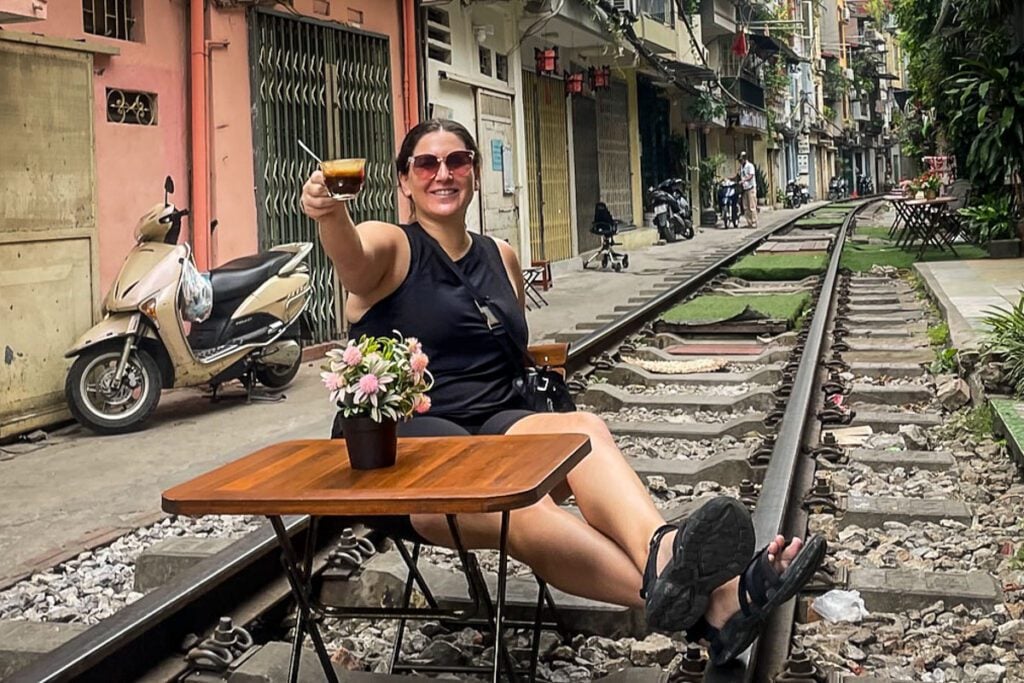
Written by Guest Author: Cat Roberts
Grab your chopsticks and get ready to explore Vietnamese street food!
Setting foot in Vietnam isn’t just another vacation; it’s an absolute feast waiting to happen.
But, let’s be real – diving into Vietnamese cuisine can be like entering a tasty maze, especially if you’re unfamiliar with the language or the sheer range of regional specialties. Lucky for you, I’ve been there, done that during my three months in Vietnam.
So, let’s take a look at the incredibly delicious Vietnamese street food you absolutely can’t miss. From street-side gems to tucked-away market treasures, we’re about to explore the Vietnamese dishes that make this country a dream for anyone who loves to eat.
Get ready for a taste adventure through the vibrant world of Vietnamese cuisine – it will be one delicious ride!
Vietnamese Street Food Guide
For more information on Vietnamese street food, jump to the following sections (or just keep scrolling to see it all!).
- Why trust me?
- Best Vietnamese street food
- Round up of Vietnamese street food
- Vietnamese cuisine by region
- Vietnamese ingredients
- Vietnamese vocabulary to know
- Things to know about Vietnamese street food
Why trust me?
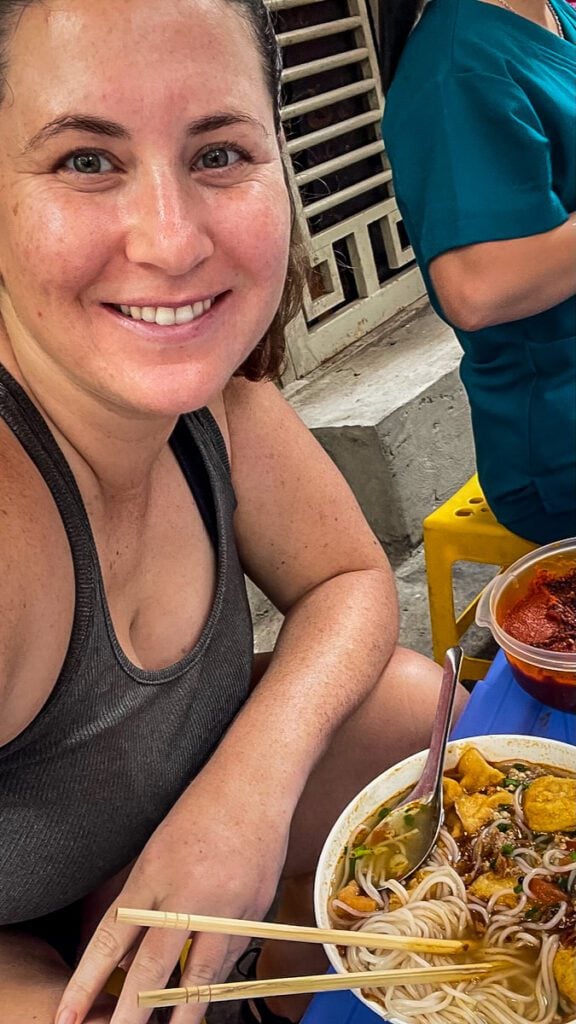
I’ve been on the road for a solid 2.5 years, and let me tell you, the best part of my day revolves around what’s on my plate.
I’m that person who plans their entire day based on what delicious bites I can discover. Vietnam, with its incredible variety of flavors and food traditions, is a real playground for a foodie like me. Plus, it’s cheap!
Eating Vietnamese street food was my daily ritual, and exploring the culinary scene was practically a way of life. I even took not one but two food tours in Vietnam to unravel the secrets behind each dish.
Now, armed with those experiences and a passion for sharing good food tales, I’m here to be your culinary guide.
Best Vietnamese street food
Here are the top Vietnamese street foods to try—way more than just pho and spring rolls (although, don’t get me wrong, those are tasty!). Let’s dive in and explore the deliciousness Vietnam offers beyond the usual suspects!
If you’re looking for the very best Vietnamese street food to try, here are our top recommendations:
- Pho
- Banh Mi
- Vietnamese Coffee
- Bun Bo Hue
- Bun Cha
While there’s no official national dish of Vietnam, these Vietnamese dishes are contenders.
Keep reading for more detailed information on each of these foods and more ideas for Vietnamese street food you should try on your next visit to this incredible country.
1. Phở
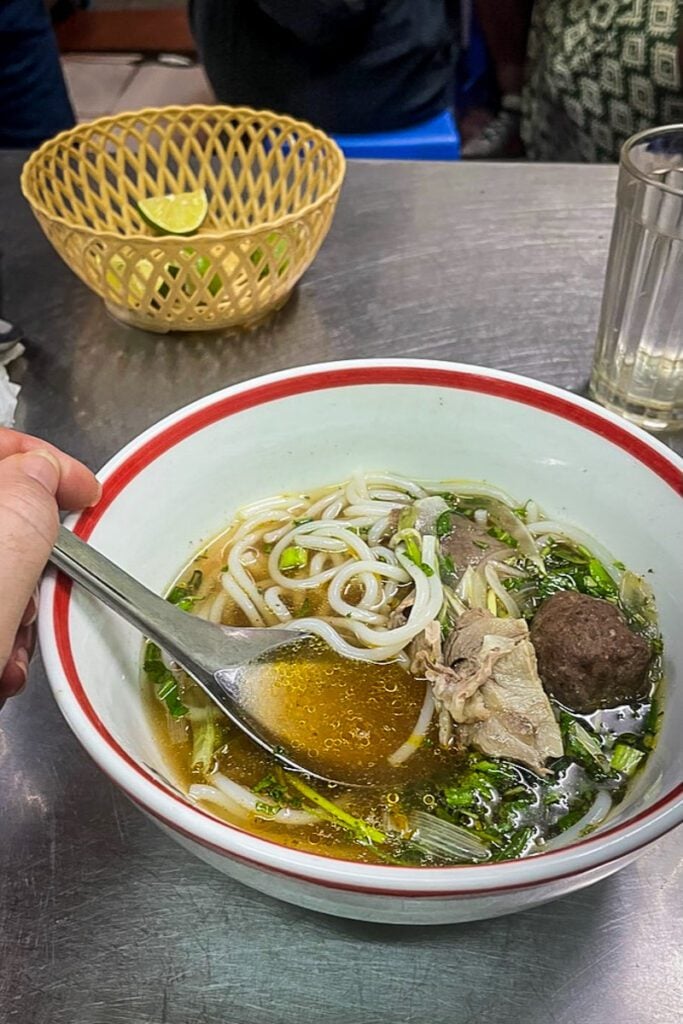
Hailing from the vibrant streets of Hanoi, Pho is Vietnam’s iconic noodle soup that has won over hearts worldwide. This aromatic dish features flat rice noodles swimming in a fragrant, clear broth, usually with beef (Pho Bo) or chicken (Pho Ga).
The magic lies in the carefully simmered broth, infused with a symphony of flavors from spices like star anise, cinnamon, and cloves. Thinly sliced meat, typically rare beef or tender chicken, is added to the piping hot broth, cooking to perfection in seconds.
Pho is often served with a side of fresh herbs such as scallion, cilantro (coriander), onion, basil, bean sprouts, lime, and chili. The garnishes allow you to tailor each spoonful to your liking, creating a harmonious blend of textures and tastes.
Where to order: Pho stalls and eateries are scattered across every corner in Vietnam, but for an authentic Hanoi experience, visit Pho 10 Ly Quoc Su in the Old Quarter. Their steaming bowls of Pho Bo will transport you to noodle heaven.
2. Banh Mi
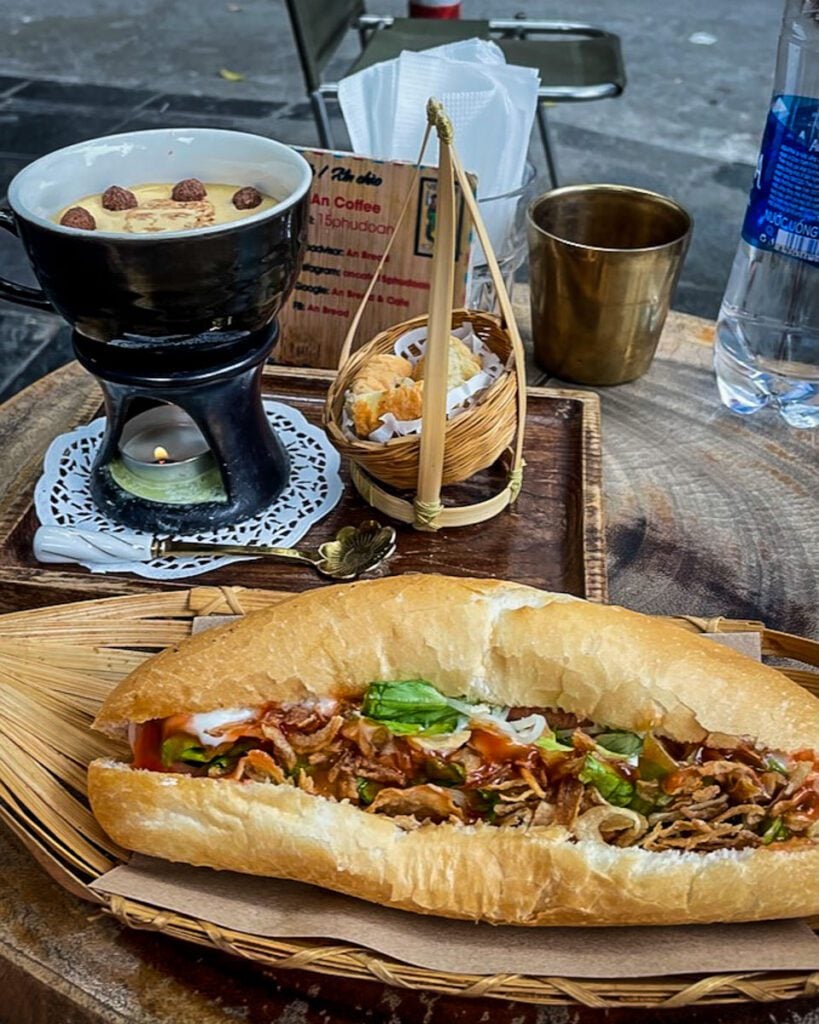
Originating from the busy streets of Saigon (thanks to French influence), Banh Mi is a Vietnamese sandwich that has a flavor explosion in every bite. Picture a crusty baguette filled to the brim with a symphony of ingredients.
At the heart of Banh Mi is a fusion of savory and sweet flavors, thanks to a spread of pâté, accompanied by various protein options like grilled pork, lemongrass chicken, egg, or Vietnamese cold cuts. The sandwich is then layered with pickled daikon and carrots for a satisfying crunch, fresh cilantro for a burst of herbaceousness, and sliced cucumbers for a refreshing kick.
What truly elevates Banh Mi is the magical concoction of condiments—mayo, soy sauce, and the all-important touch of Maggi seasoning. The result? A harmonious blend of textures and tastes makes Banh Mi a beloved street food sensation.
Where to order: Banh Mi are found on almost every corner in Vietnam, usually sold from a small cart during breakfast time for less than $1 USD. For a delicious Banh Mi experience in Saigon, head to Banh Mi Hong Hoa. And in Hoi An, try Madam Khanh.
3. Vietnamese coffee (and beyond!)
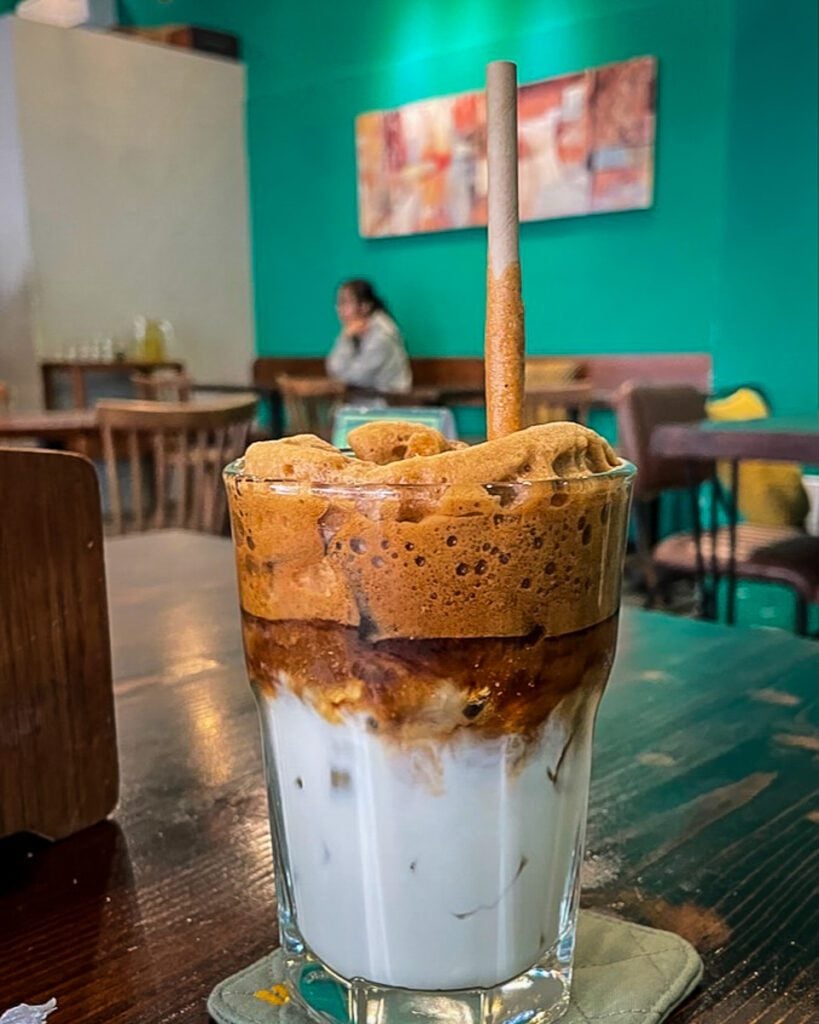
Forget your regular cup of joe; this is a rich, slow-drip coffee that packs a punch.
Robusta coffee drips slowly into a cup containing sweetened condensed milk using a traditional drip filter. The result? A strong and smooth concoction that’s both energizing and indulgent.
You can also opt for “Ca Phe Sua Da,” which is iced Vietnamese coffee – perfect for those warm afternoons.
Now, let’s explore some unique twists:
- Coconut coffee: For a tropical flavor burst, try coconut coffee. This delicious concoction combines Vietnamese coffee’s richness with coconut milk’s creamy sweetness. I was obsessed with iced coconut coffee when I lived in Danang (an excuse to have dessert at breakfast).
- Egg coffee (Ca Phe Trung): A Hanoi specialty, this is a luxurious treat where egg yolks are whipped with condensed milk and poured over hot coffee, creating a velvety, indulgent custard-like dessert.
- Salt coffee (Ca Phe Muoi): A surprising combination, salt coffee adds a savory touch to traditional Vietnamese coffee. It’s a unique flavor that’s worth a try.
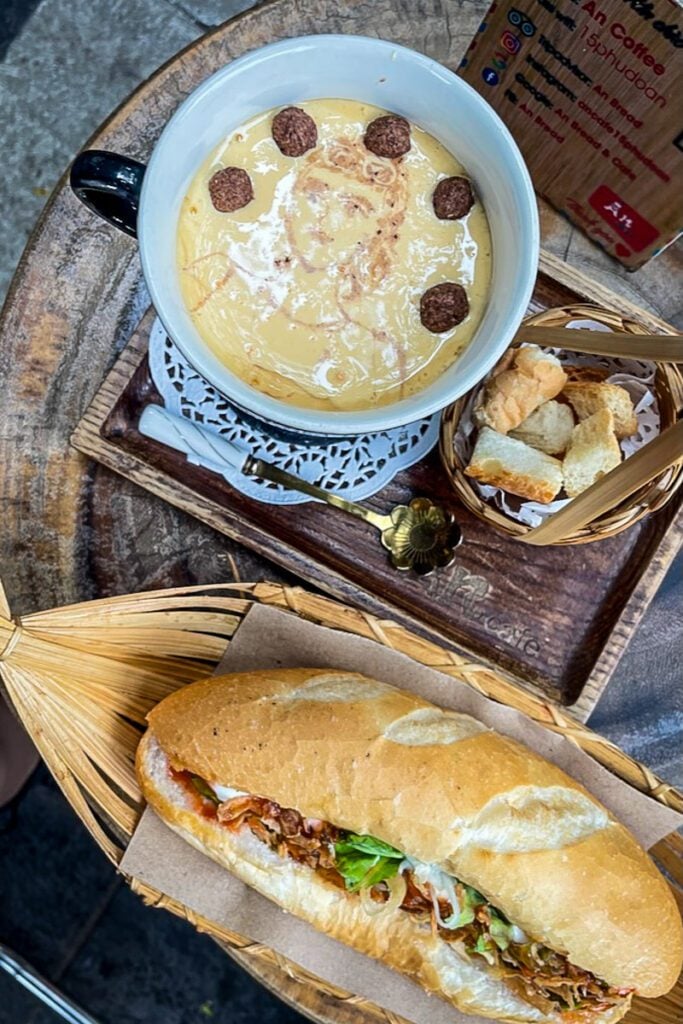
Vietnamese coffee culture is more than just a beverage; it’s a moment to savor, often enjoyed slowly while watching the world go by.
Rainy season began while I was in Hoi An, and I would have been lost if it weren’t for cute cafes on every corner!
Where to order: There are cafes on every block and hidden down every alleyway in Vietnam. I recommend Cafe Giang in Hanoi, Little Hanoi Egg Coffee in Saigon, and Umm Banh Mi in Danang.
4. Bun Bo Hue
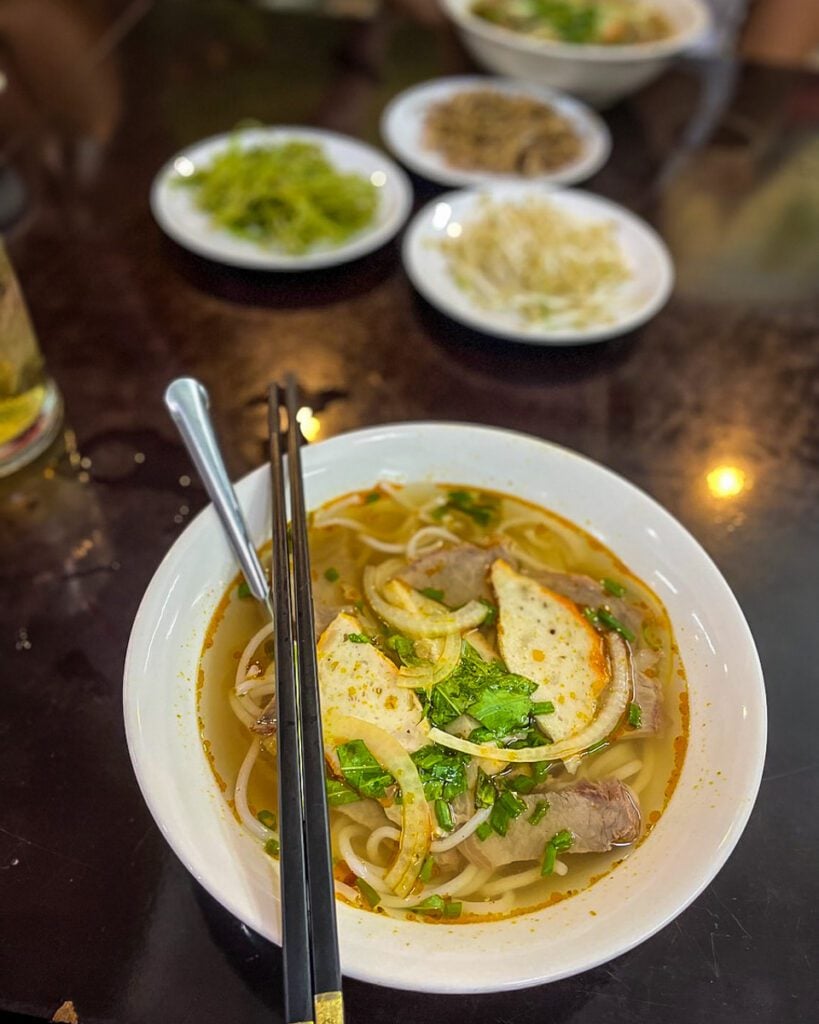
Hailing from the central Imperial city of Hue, Bun Bo Hue (pronounced Hu-way) is a beef noodle soup with a spicy and flavorful punch. This dish celebrates bold and aromatic Vietnamese flavors, featuring rice vermicelli noodles in a robust broth made with lemongrass, beef bones, and fermented shrimp paste.
The star of the show is the meat – typically, slices of beef brisket and sometimes pork swim alongside the noodles, creating a hearty and satisfying meal. The distinctive spicy kick sets Bun Bo Hue apart, thanks to adding chili oil or fresh chilies.
Garnished with fresh veggies like bean sprouts, banana flowers, morning glory, and a squeeze of lime, Bun Bo Hue is a culinary adventure that captures the essence of central Vietnamese cuisine.
Where to order: To experience the authentic flavors of Bun Bo Hue, head to Bun Bo Hue Mu Roi, a renowned eatery in the city of Hue. Try it in Saigon at Bun Bo Hue Mo Noi Co Nhu or in Hanoi at Pho Bo, Bun Bo Hue O Ton.
5. Bun Cha
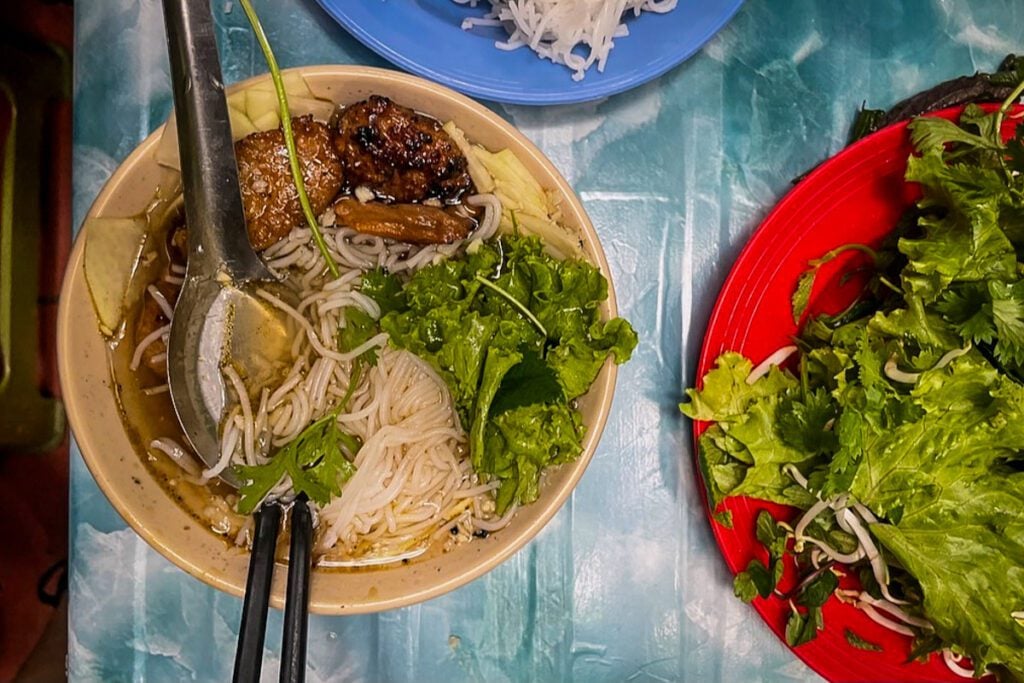
Straight from the streets of Hanoi, Bun Cha is a classic Vietnamese street food that combines grilled pork, rice noodles, and abundant fresh herbs.
The star of Bun Cha is the succulent pork patties, marinated to perfection and grilled until they boast a caramelized exterior. These flavorful patties are served in a bowl of sweet and savory fish sauce, accompanied by a generous heap of rice vermicelli and a medley of fresh herbs, including mint, cilantro, and basil.
Bun Cha is often served with pickled vegetables to add a bit of crunch and acidity. The result is an amazing interplay of smoky, sweet, and savory flavors.
Just as one of the best reasons to visit Chiang Mai in Thailand is for a bowl of khao soi noodles, Hanoi offers its own culinary gem – a bowl of Bun Cha – and I’d visit Hanoi again just for that.
Where to order: For an authentic Bun Cha experience in Hanoi, make your way to Bun Cha Hang Quat, where you’ll walk down a narrow alleyway to one of my favorite places to eat in all of Vietnam.
6. Banh Xeo
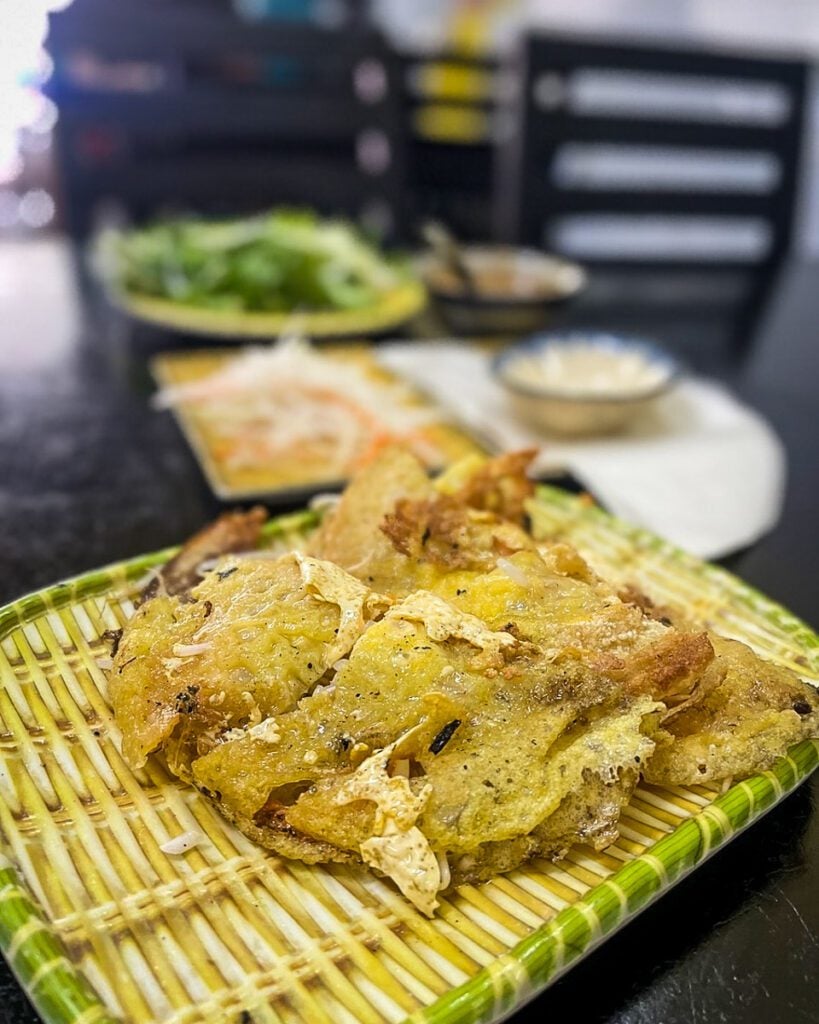
Hailing from the Mekong Delta but adored nationwide, Banh Xeo is a Vietnamese crispy pancake that’s an interesting fusion of textures and flavors. Banh Xeo translates to “sizzling cake,” capturing the dish’s essence as it sizzles in the pan.
These golden pancakes are made from a batter of rice flour, coconut milk, and turmeric, creating a vibrant color. They are generously filled with shrimp, pork, bean sprouts, and green onions. The key is the crispy outer layer, achieved by frying the pancakes until they achieve a perfect golden-brown crunch.
To enjoy Banh Xeo, tear off a piece of the pancake, wrap it in fresh lettuce leaves, and dunk it into a dipping sauce made with fish sauce, lime, and chili. The result is a satisfying combination of crispy, savory, and fresh flavors in every bite.
Where to order: For an authentic Banh Xeo experience, visit Banh Xeo Ba Hai in Ho Chi Minh City, where they serve up these golden pancakes with a side of Vietnamese hospitality. If you take a tour of the Mekong Delta, you’ll probably try Banh Xeo there, too!
7. Cơm Gà (chicken and rice)
Straight out of Hoi An, Com Ga is a Vietnamese street food dish that transforms everyday ingredients into a flavor-packed masterpiece. The star of the show is the tender, turmeric-infused shredded chicken.
At its core, Com Ga features fragrant chicken rice cooked in a broth made from chicken bones for that savory goodness. The shredded chicken is laid on top, accompanied by fresh herbs, scallions, and crispy shallots.
Served with a side of clear chicken broth, Com Ga allows you to tailor the flavor intensity to your liking. A drizzle of fish sauce or a squeeze of lime adds the perfect finishing touch, elevating this Hoi An specialty to a whole new level.
Where to order: For an authentic Com Ga experience, head to Com Ga Mom in Hoi An, a renowned spot that locals and visitors love.
8. Bánh Cuốn
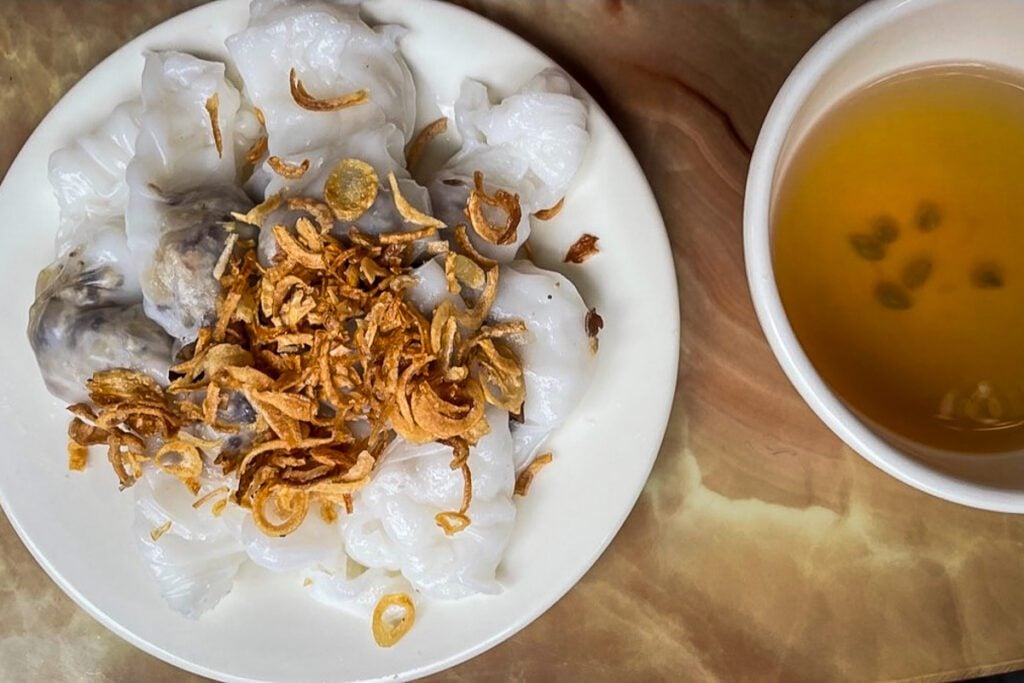
A hidden gem in Vietnamese cuisine, Bánh Cuốn is a dish that might not be on everyone’s radar. Originating from Northern Vietnam, this dish showcases delicate rice sheets rolled with a savory filling, creating a great mix of textures. It’s great for breakfast!
The star of Bánh Cuốn is the thin, steamed rice sheets, almost translucent. These sheets are filled with a savory mixture of minced pork, wood ear mushrooms, and shallots. The result is a light, flavorful roll that bursts with umami goodness.
To elevate the experience, Bánh Cuốn is often served with fresh herbs, crispy fried shallots, and a dipping sauce made with fish sauce, kumquat, and chili. Squeeze the kumquat right into the fish sauce before you dip.
Where to order: For an authentic Bánh Cuốn experience, visit Bánh Cuốn Gia Truyen in Hanoi, where the traditional preparation of this dish has been perfected over generations.
9. Bún Bò Nam Bộ
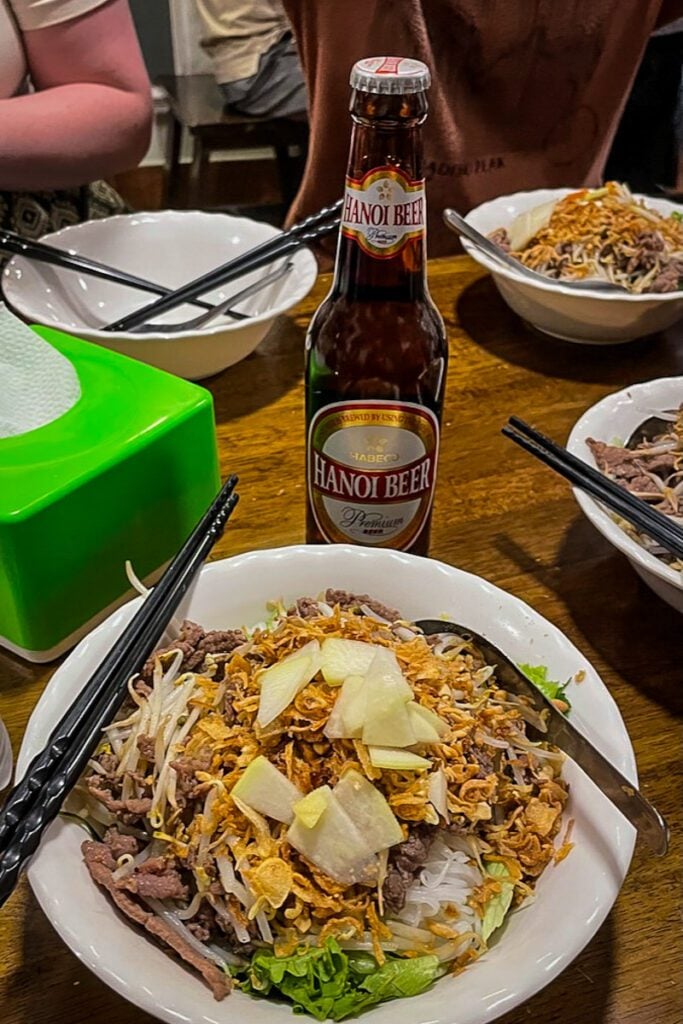
A vibrant explosion of flavors, Bún Bò Nam Bộ is a Southern Vietnamese beef noodle dish that I ate over and over again – it’s so delicious! This famous Vietnamese dish showcases a bed of vermicelli noodles topped with lots of garnish and without broth.
At the heart of Bún Bò Nam Bộ is marinated and stir-fried beef. Accompanying the beef are fresh herbs, bean sprouts, pickled carrots, and crushed peanuts, creating the perfect contrast of crunch and freshness.
To tie it all together, a drizzle of nuoc mam-based sauce featuring fish sauce, lime, sugar, and chili, adds a burst of umami and a hint of heat.
Where to order: Although this is a Vietnamese dish that is technically from South Vietnam, the best bowl of Bun Bo Nam Bo I had was in Hanoi at Bun Bo Nam Bo Bach Phuong. I first went there on a food tour and then returned multiple times.
10. Goi Cuon (spring rolls)
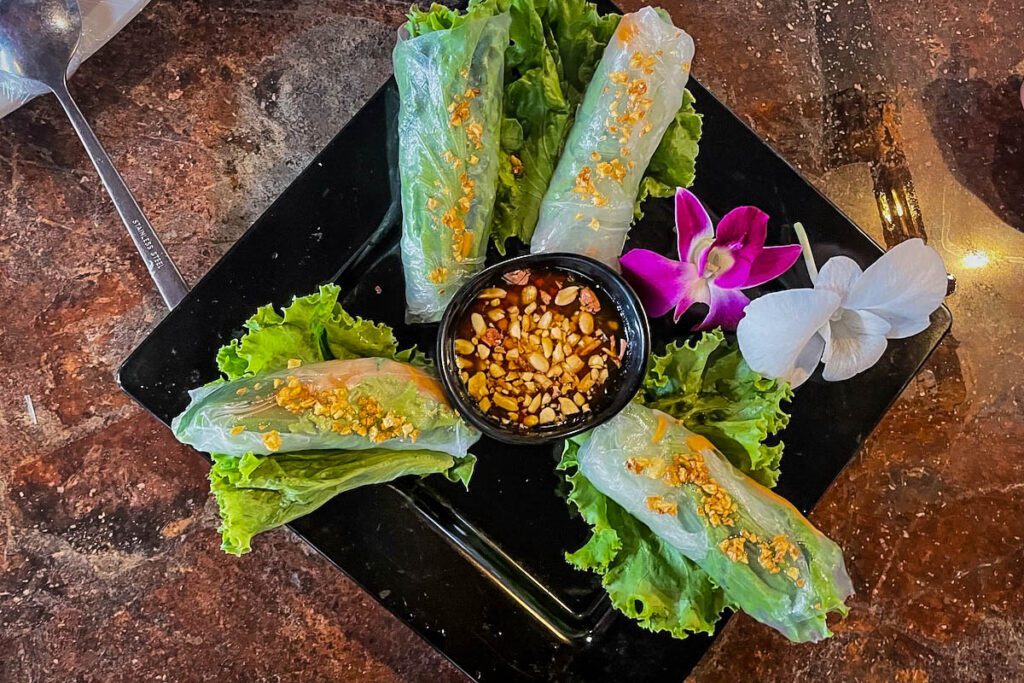
Here’s a classic Vietnamese street food you’ve likely tried before: Goi Cuon is also known as “spring rolls”. You can order them either fried or fresh.
In Vietnam, these are often called spring rolls, but in some places, they’re known as summer rolls (particularly when they’re fresh, not fried, and when you have to roll them yourself).
These rolls are like little flavor packages. You’ve got shrimp, herbs, pork, rice vermicelli, and sometimes a crispy element all wrapped up in rice paper. It’s easy to find vegetarian spring rolls, too.
Don’t forget to dip them!
Where to order: Almost every Vietnamese restaurant has spring rolls. Try them at Den Long in Ho Chi Minh or Tung’s Kitchen in Hanoi.
11. Cao Lau Noodles
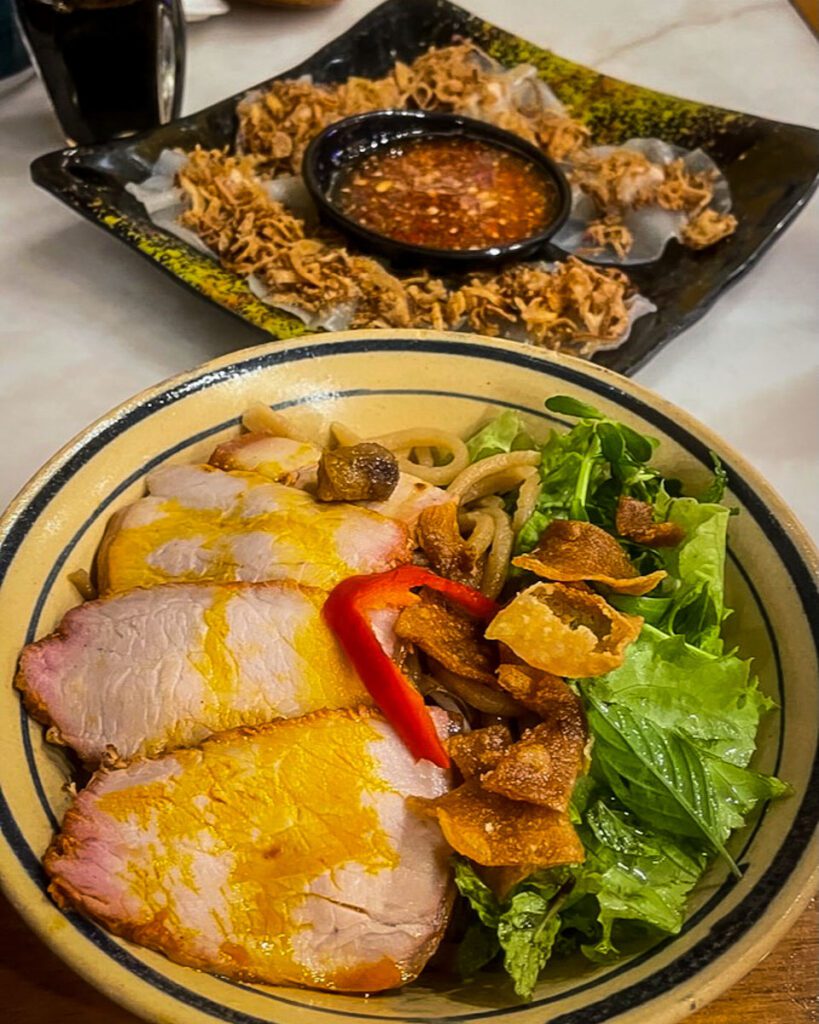
As one of Hoi An’s most famous Vietnamese foods, I’m a little obsessed with Cao Lau Noodles.
Cao Lau is made with thick rice noodles, hearty and chewy, bathed in a broth infused with a secret blend of spices and herbs.
But here’s what makes Cao Lau so special – the water used in cooking these noodles is drawn from the nearby Ba Le well, dug by the Cham people. Located at the end of an alley opposite 35 Phan Chau Trinh Street, this well gives the dish unparalleled flavor that can’t be replicated outside Hoi An.
The noodles are prepared with a solution sourced from trees on Cham Island and take on a distinct yellow hue and a slightly firm texture.
Slices of pork – not too tender or firm – sit on top of the noodles. Add some crisp greens, bean sprouts, and crunchy rice crackers, and you’ve got the magic that is Cao Lau.
Where to order: Head to Quan Cao Lau Ba Le to try Cao Lau Noodles and White Rose dumplings. I ate here while it poured down rain outside, and I’ll never forget it!
12. Mì Quảng Noodles
Mì Quảng noodles—a local favorite from the central region —are made with wide rice noodles, a bit chewy, soaking up a slightly golden broth from turmeric.
In that broth, you’ve got a mix of shrimp, pork, and sometimes quail eggs, all playing together to make your taste buds dance.
The garnish is what makes the most popular Vietnamese dishes dance. Fresh herbs, crunchy peanuts, rice crackers, and a squeeze of lime take this bowl of noodles to the next level.
Where to order: If you want the real deal, try Mi Quang Ong Hai —I would have come to Hoi An just for these!
13. Morning Glory
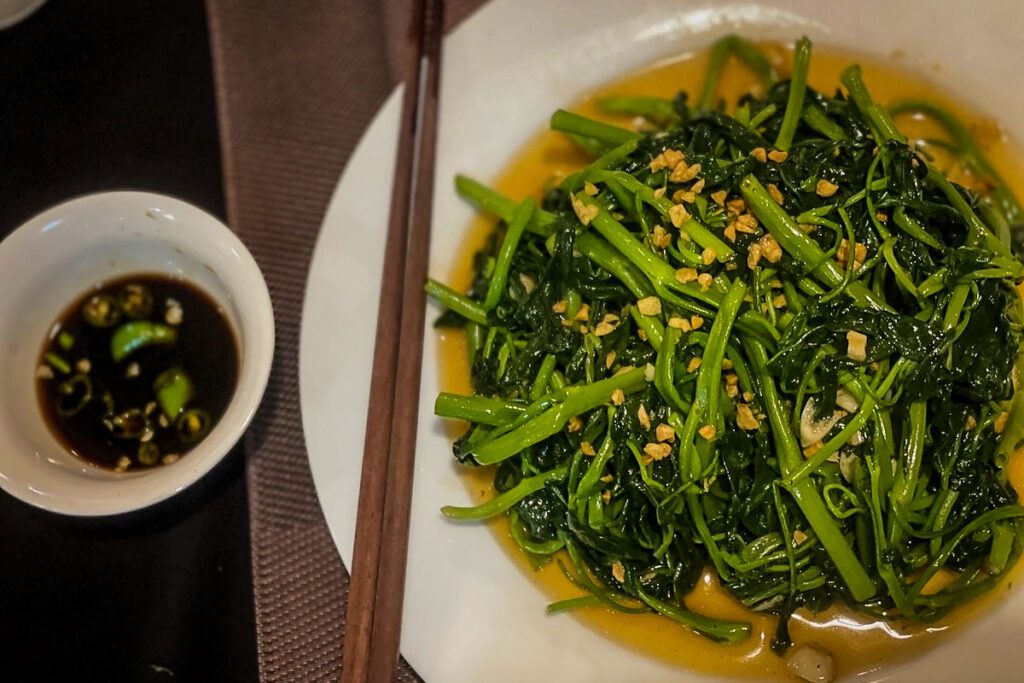
Now, let’s talk about Morning Glory, not the flower, but a popular Vietnamese street food you’re likely to encounter on your travels. Morning Glory, or “Rau Muống” in Vietnamese, is a green vegetable that makes a perfect side dish for every meal.
Tender morning glory stems are stir-fried to perfection, creating a simple dish that’s bursting with freshness. The magic lies in combining garlic, soy sauce, and sometimes a hint of chili.
The simplicity of Morning Glory is its charm. It’s a quick stir-fry that captures the essence of Vietnamese street food – uncomplicated, tasty, and always satisfying.
I ate a plate of morning glory nearly daily in Vietnam – it’s the most common vegetable in restaurants.
Where to order: Morning Glory is a staple on Vietnamese menus, so you’ll find it everywhere and always delicious.
14. White Rose Dumplings
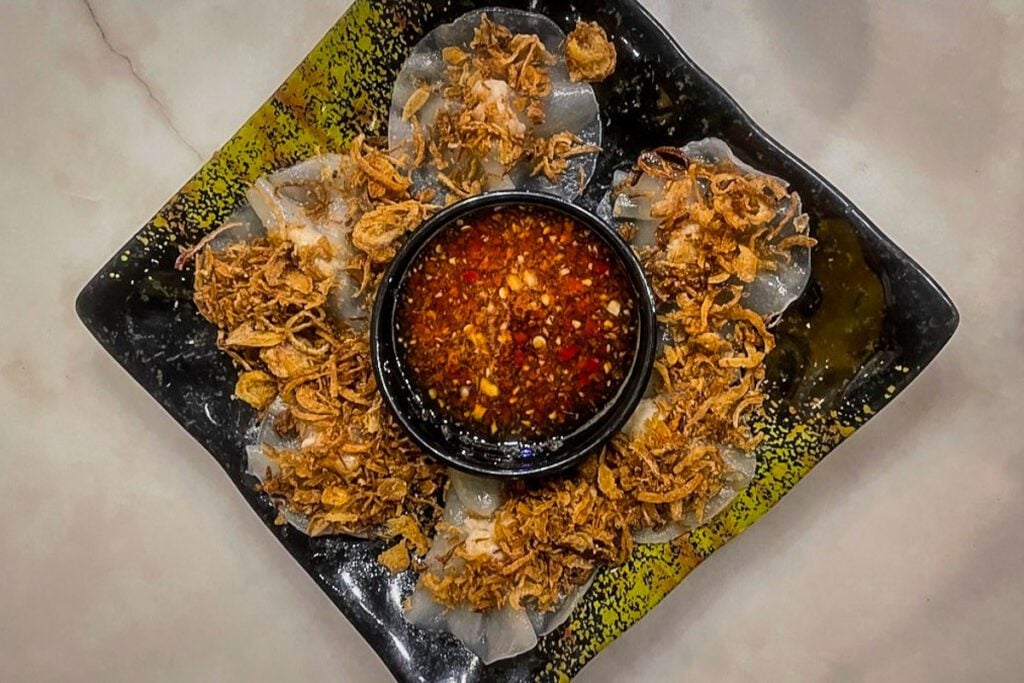
You’ll only find White Rose Dumplings—”Bánh Bao Vac” in Vietnamese—in Hoi An.
They’re made of translucent rice dough meticulously folded into rose-shaped dumplings, filled with a flavorful mix of shrimp and spices, and steamed to perfection. The best part is the heaping serving of crispy shallots sprinkled on top – all Vietnamese dishes should have a crispy shallot topping in my opinion!
The secret behind White Rose Dumplings lies in the hands of Tran Tuan Ngai, a third-generation guardian of the traditional recipe, residing at 533 Hai Ba Trung Street. His family supplies the dumplings to various restaurants in Hoi An, making it truly exclusive.
Where to order: Since every restaurant in Hoi An gets the dumplings from the same family, it doesn’t matter where you get them. I recommend Quan Cao Lau Ba Le to try both Cao Lau Noodles and White Rose dumplings.
15. Papaya Salad
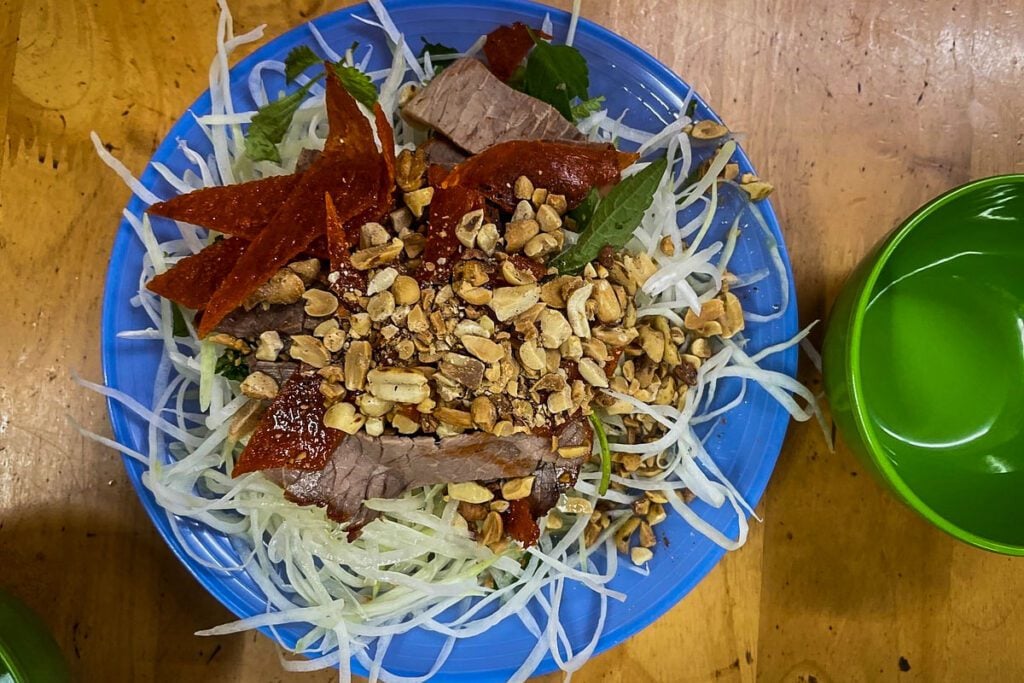
Known as “Gỏi Đu Đủ” in Vietnamese, this papaya salad dances with flavors that are different from its popular Thai counterpart.
This popular Vietnamese dish has strands of green (unripe) papaya skillfully shredded and mixed with a medley of ingredients – carrots, Vietnamese herbs, peanuts, and sometimes, a slice of beef jerky for that extra kick. The dressing, a blend of fish sauce, lime, and chili, ties everything together.
Its balance of sweet, sour, and savory flavors makes Vietnamese Papaya Salad distinct. The use of local herbs adds a layer of freshness, while the inclusion of beef jerky introduces a savory crunch.
Where to order: Papaya Salad is a staple in Vietnamese street food, and you can find it in local eateries or street stalls throughout the country. A great local spot in Hanoi to try the beef-topped papaya salad is Long Vi Dung Nom Thit Bo Kho.
16. Tropical Fruits
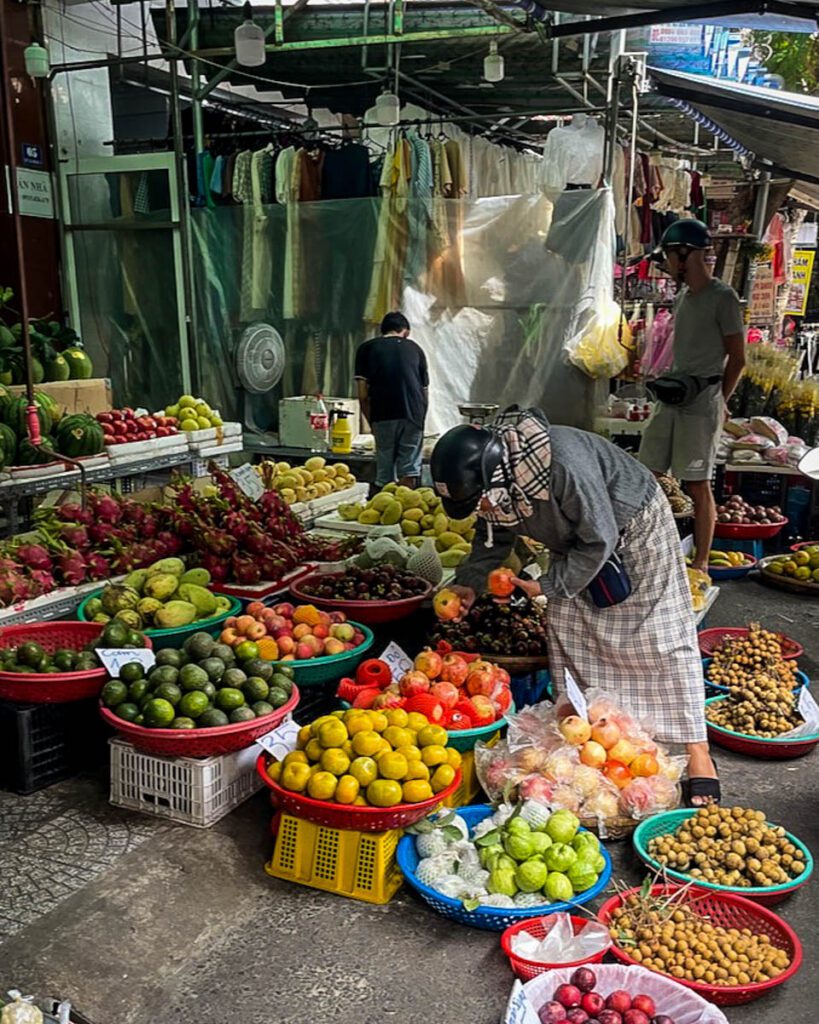
One of my favorite things when traveling is to explore a local market and try fruits I’ve never tried before. Vietnam is a treasure trove of tropical fruits; diving into local markets is a must-do activity.
My fascination with exotic fruits began in El Salvador, another country worth visiting for its diverse selection of fruits.
The most infamous fruit you’ll find is the notorious Durian, known for its pungent aroma but beloved for its creamy texture and rich taste. People either love it or hate it.
Milk Apple, with its sweet and milky flavor, reminds me of persimmon but has a more subtle flavor. Longan, resembling lychee with its distinct sweet and floral notes, is another one to try – watch out for the pit.
Where to order: Every neighborhood has outdoor markets where locals shop for fresh produce. In Hanoi, there are several fruit vendors by the train station. Keep your eyes peeled, or ask your hotel/tour guide for directions to the nearest market!
17. Nem Cua Bể (Crab Spring Rolls)
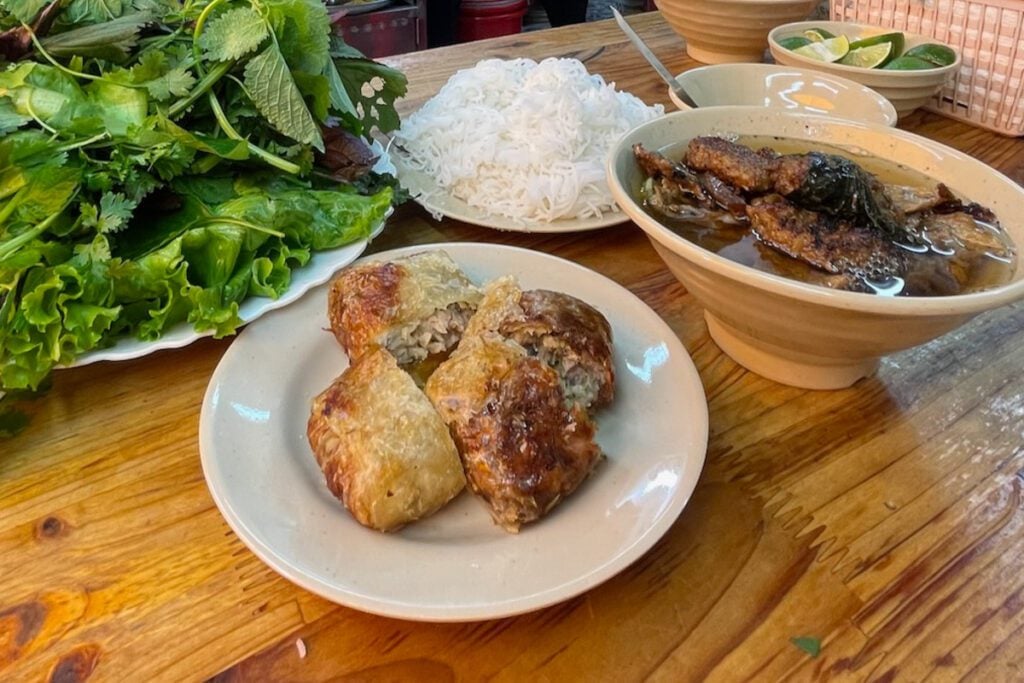
Also known as deep-fried crab spring rolls, Nem Cua Be is a nice change from traditional spring roll flavors and a popular Vietnamese street food.
Nem Cua Be showcases the perfect marriage of delicate crab meat, minced pork, black mushroom, and a harmonious blend of Vietnamese spices.
The magic happens when these stuffed rolls meet hot oil, changing into the perfectly crunchy dish you’ll love.
To enjoy Nem Cua Bể in its full glory, the traditional Vietnamese way is to wrap a piece in fresh lettuce leaves with aromatic herbs and dip it into a zesty dipping sauce.
Where to order: Crab spring rolls are almost always served alongside bowls of Bun Cha in Hanoi. Quan Bun Cha is a good place to try it!
18. Rice Wine, aka “Happy Water”
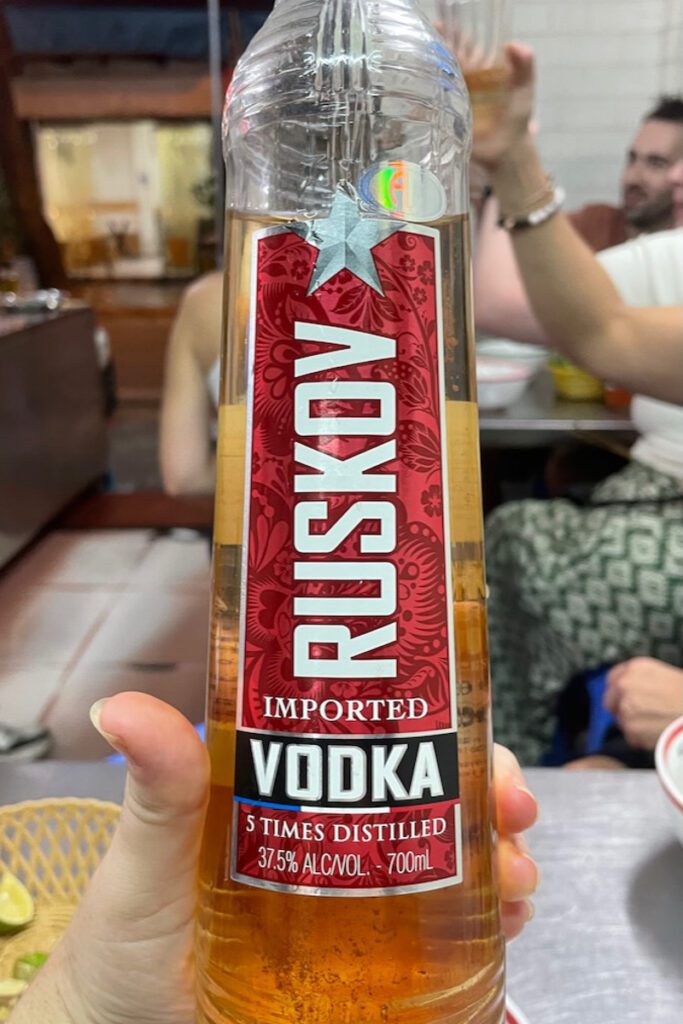
Vietnamese cuisine is not just about the food; it’s also about having a good time with friends! And that brings us to the infamous “happy water,” also known as Vietnamese rice wine.
Rice wine, known as “rượu gạo” in Vietnamese, is the country’s most popular liquor, traditionally distilled from fermented rice. Often brewed at home, this rice liquor features an alcohol content higher than 40% by volume. It has a clear appearance, sometimes a bit cloudy if not filtered.
Historically, Vietnam had a monopoly on liquor production, and this home-brewed alcohol was akin to American moonshine. Happy Water may not possess the refinement of the wines you’re accustomed to, especially the cheap one we drank on the Ha Giang loop. That must be what rubbing alcohol tastes like.
At the end of each day of my motorbike tour on the Ha Giang Loop, we ended the day by raising glasses of Happy Water in toasts and cheers, which I’ll never forget!
Remember the famous Vietnamese toast: “Mot, Hai, Ba, Dzo!” (One, Two, Three, Cheers!)
19. Bun Rieu
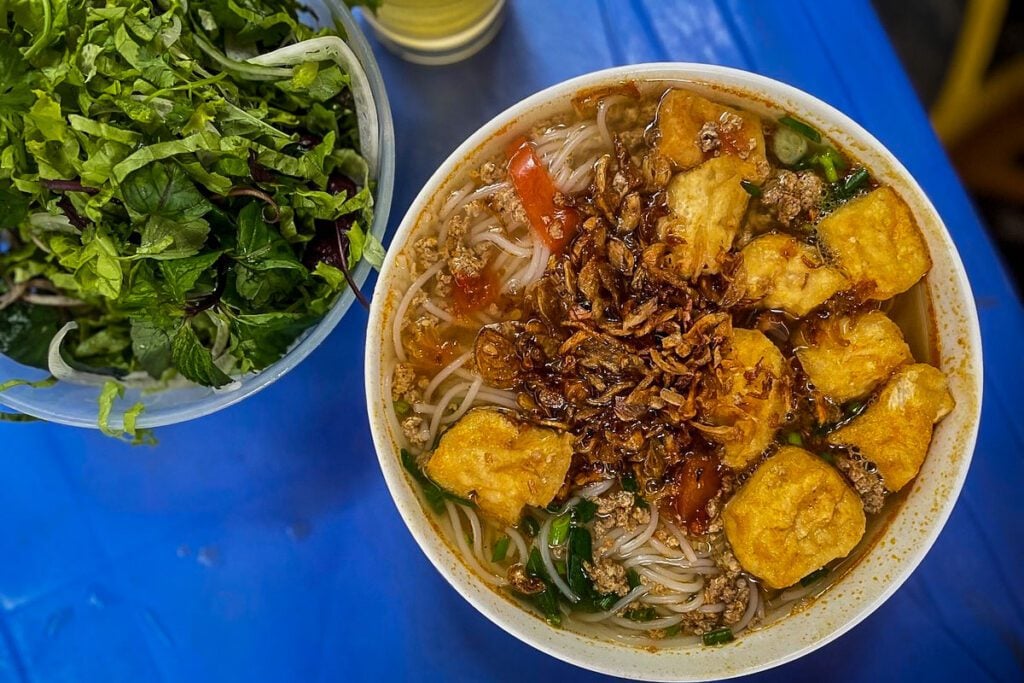
Bun Rieu, a Vietnamese crab-based soup noodle dish, is one of my favorite foods to eat in Vietnam, and if I’m being honest, I prefer it to most of the bowls of pho I had. One of the most popular versions is bun rieu cua, featuring crab, tomatoes, pork, and tofu.
The heart of this dish lies in the crab paste made from paddy crabs, infusing the broth with its distinctive flavor. Stewed tomatoes further enhance the broth, adding a slightly tart and natural sweetness.
Alongside rice vermicelli noodles, you’ll find tender pieces of meat, crab paste, and an array of condiments like shrimp paste, chilies, and lime. Mix in lots of greens and a dab of shrimp paste to make the flavors pop.
Where to order: I had a delicious bowl of bun rieu at Bun Rieu Suon Sun Trang and was the only tourist there. They had a menu in English for me – I added fried tofu, which was perfect.
20. Fresh seafood and snails
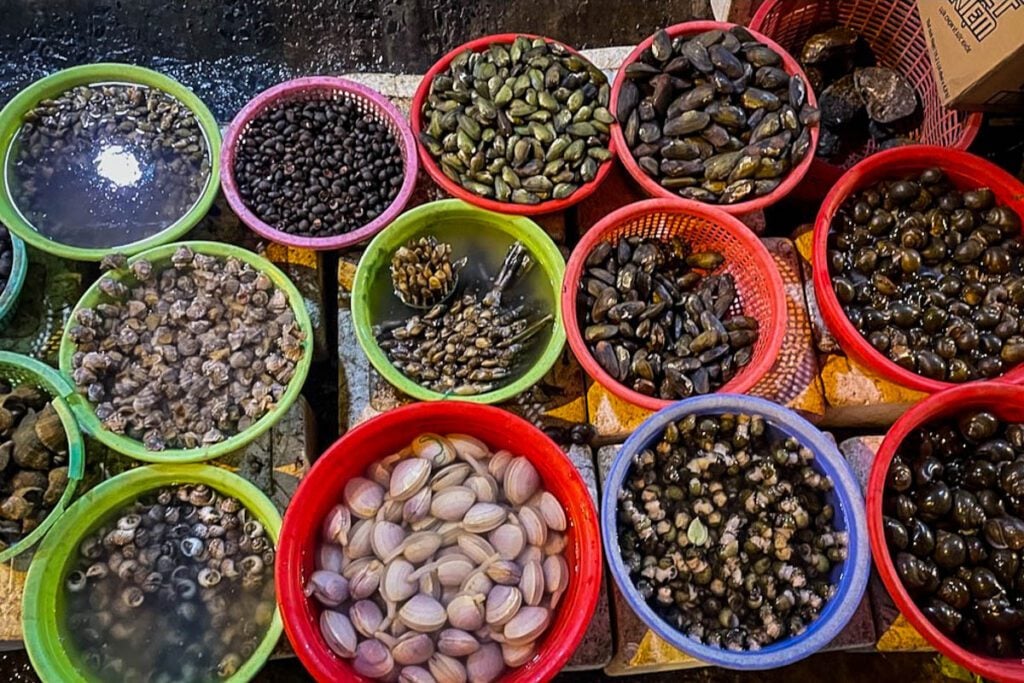
When you look at a map of Vietnam, you’ll see the country has an extensive coastline, and you know what that means—lots of delicious seafood!
Some must-try Vietnamese dishes in the seafood category are freshly caught squid, shrimp, clams, and fish, all expertly grilled to a smoky, charred perfection. There’s always a delicious sauce to dip into.
If you’re feeling brave, try the snails. Vietnam takes snails to a whole new level. Whether it’s stir-fried snails with lemongrass and chili (Ốc Xào Sa Tế) or snails in coconut milk (Ốc Len Xào Dừa), each dish is a fan favorite.
While fish isn’t exclusive to coastal areas, Hanoi’s Chả Cá Lã Vọng is a standout dish. Marinated chunks of snakehead fish are grilled at your table and served with vermicelli noodles, fresh herbs, and peanuts.
Where to order: Head to Mrs. Truoc’s Snail Stall in Saigon, made famous by Netflix a couple of years back. Ong Cua is a great place for fresh seafood and cold beer. My food tour brought us to Oc Oanh – get the crab claws and scallops!
21. Grilled goat
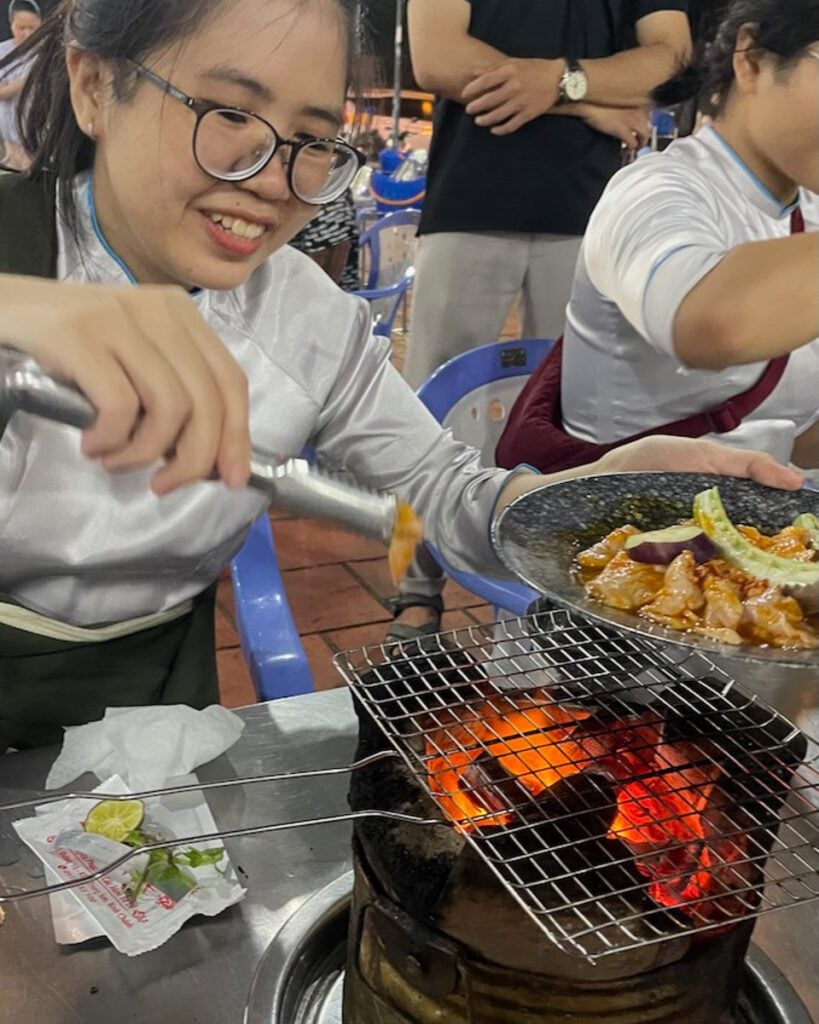
While goat meat might not be as commonly associated with Vietnamese cuisine as other meats, it’s a local delicacy worth exploring.
Grilled Goat is a specialty in the mountainous regions of northern Vietnam, particularly in areas like Sapa and Ha Giang. I ate grilled goat in Tam Coc, a small village in Ninh Binh province, and again in Saigon on my food tour. Goat meat tastes like lamb, and people usually love or hate it.
Here, the landscape influences the diet, and goat farming is common. The result? A flavorful and tender meat that lends itself perfectly to grilling.
The marinated goat meat was succulent, and the herbs on the side added great flavor. Some more traditional restaurants hang a full goat body in front of the restaurant like you might see in an old-style butcher shop.
Where to order: For an authentic grilled goat experience, head to Lau de Dê Nhất in Saigon. This hidden gem is located outside the tourist areas, providing a local atmosphere where you can grill your goat meat, beef, or shrimp—order with a side of morning glory.
22. Bamboo Duck
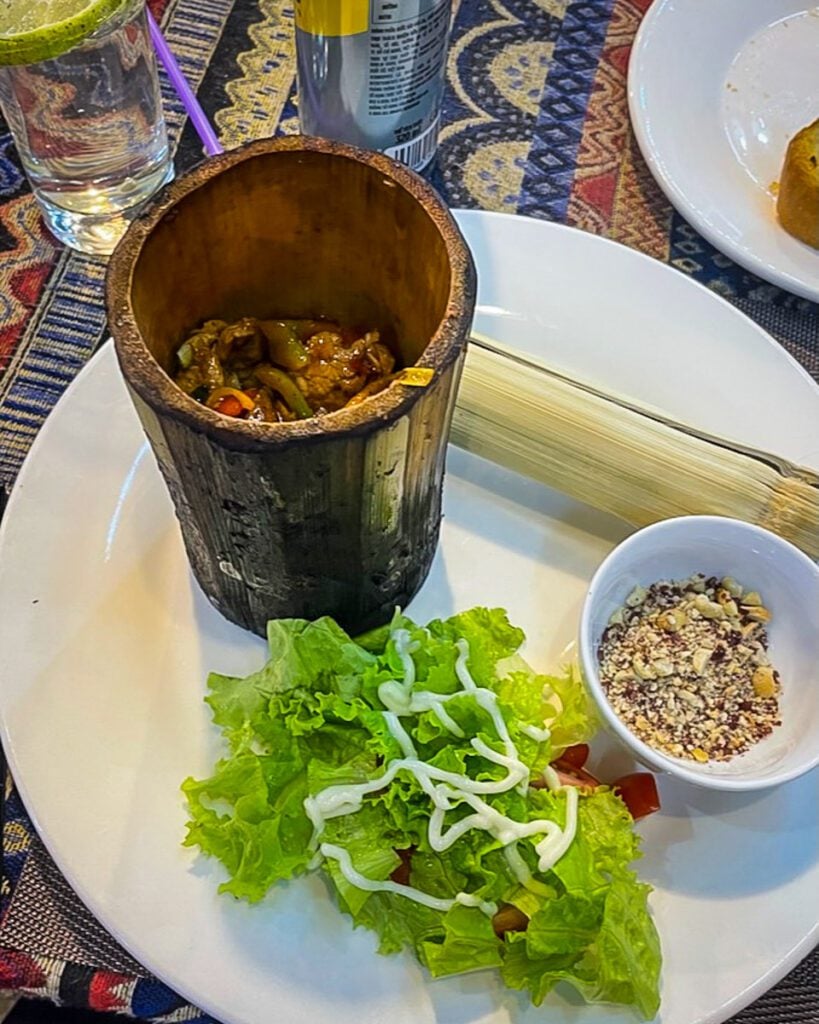
I enjoyed trying this Vietnamese dish in the picturesque town of Sapa, located in the northern mountains of Vietnam.
What makes Bamboo Duck special is the method of cooking. The duck and aromatic herbs and spices are carefully stuffed inside a bamboo pipe.
The bamboo serves as a natural vessel for the cooking process. As the duck cooks within the bamboo, it absorbs the earthy essence, producing tender and flavorful meat.
Sticky rice cooked in a bamboo pipe is perfect for soaking up the sauce.
Where to order: After hiking in Sapa, head to Hmong Restaurant for a traditional bamboo duck dinner. It will hit the spot! I love that this restaurant helps support locals from the Hmong villages.
23. Bun Cha Gio
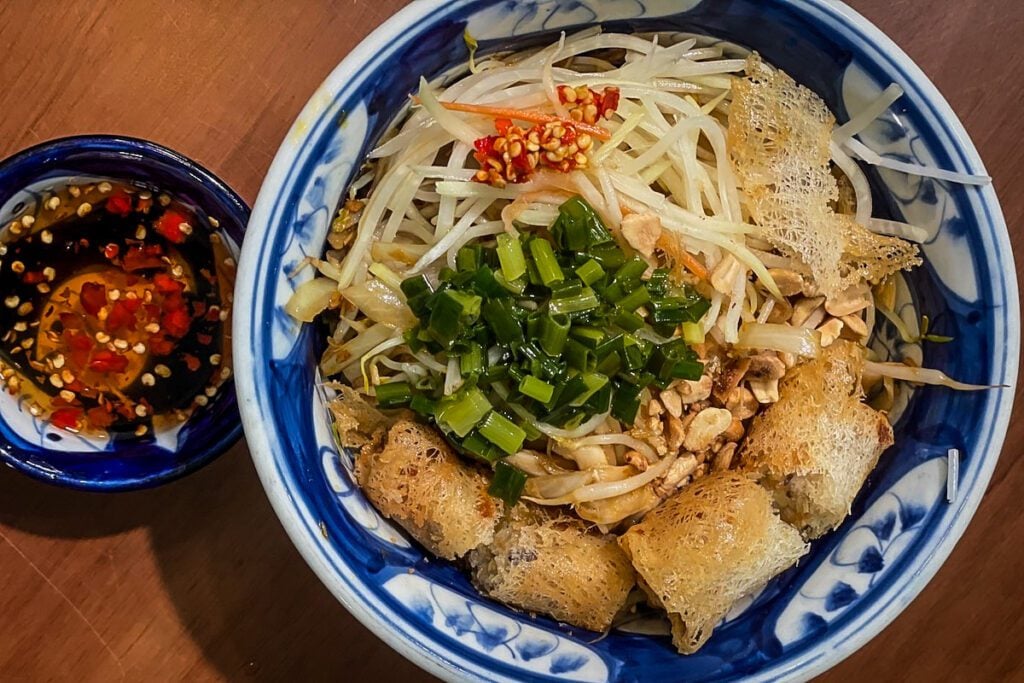
It’s important not to confuse this dish with the more renowned Bun Cha in Hanoi – Bun Cha Gio, a Vietnamese noodle salad that tastes completely different.
Bun Cha Gio comes to life by adding crispy spring rolls on top of a bowl with vermicelli noodles, fresh vegetables like lettuce, mint, cucumbers, pickled carrots, and pickled daikon. Topped with crushed peanuts and accompanied by nuoc cham, a Vietnamese dipping sauce, this dish offers a fresh option.
This is one of the first Vietnamese dishes I tasted when I landed in Vietnam at the start of my 3-month trip (I was one of the first travelers to be granted a 90-day visa!). Instead of meat, I ordered a vegetarian version with mushrooms. But it usually comes with pork or another kind of meat.
Where to order: If you reach Danang, head to Thia Go. Not only is the food delicious and reasonably priced, but the staff goes above and beyond by telling you how to eat the Vietnamese dishes like a local, so it’s a good way to dip your toes into Vietnamese cuisine. Their banh xeo is tasty too.
24. Bột Chiên
This popular Vietnamese street food is most often found sizzling on the streets of Ho Chi Minh City.
Bot Chien, also known as Fried Rice Flour Cake, features chewy cubes of rice flour cake stir-fried until crispy, then seasoned with a savory and slightly sweet soy-based sauce.
Crunchy on the outside and chewy on the inside, this dish often incorporates additional ingredients such as eggs, green onions, and sometimes Chinese sausage.
Bot Chien is commonly served with fresh green papaya salad, adding a refreshing and crunchy element to the dish.
Where to order: For an authentic Bot Chien experience, head to the streets of Ho Chi Minh City. Many Vietnamese restaurants will have it on the menu, but one of the best is found at Bot Chien Hai Van. Remember, if the dish is part of the restaurant’s name, that’s their specialty!
25. Banh Bao (Vietnamese steamed buns)
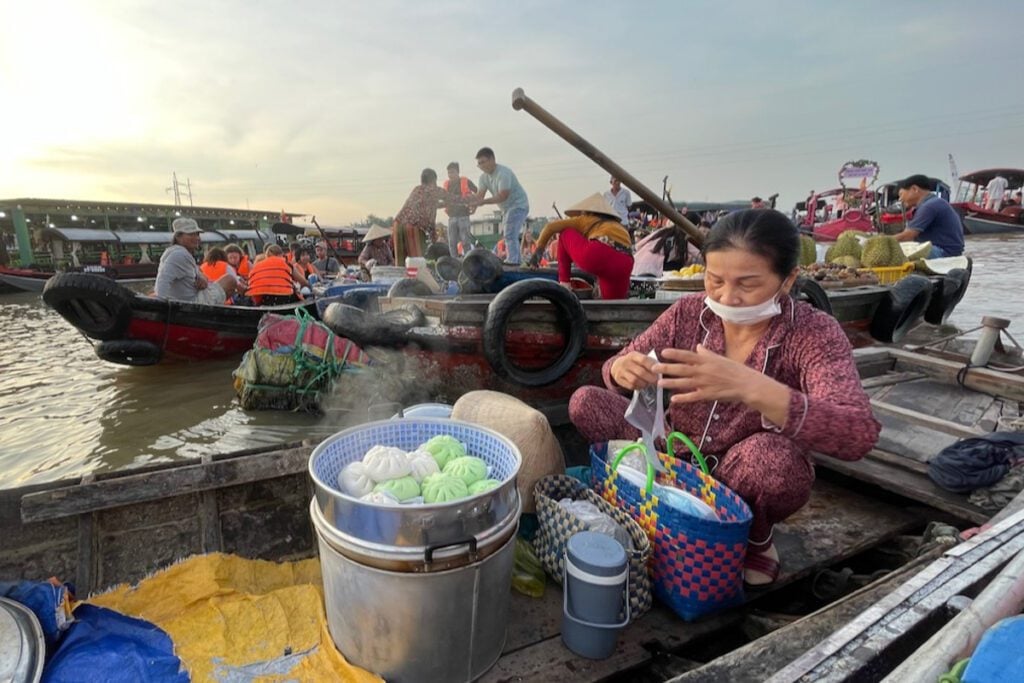
If you’ve ever eaten Chinese steamed buns, these are similar. I’m always down for a delicious bao, one of my favorite things to eat in Vietnam!
These steamed buns are known for their soft and fluffy texture and are most commonly eaten at breakfast.
The most common filling consists of minced pork, Chinese sausage, mushrooms, and sometimes a hard-boiled quail egg, all seasoned with a savory blend of soy sauce, oyster sauce, and various spices.
Whether as a snack on the go or as part of a leisurely meal, Banh Bao is one of the most famous Vietnamese street food dishes. You can find Bánh Bao in numerous street food stalls, bakeries, and markets nationwide.
Where to order: The best banh bao I had was hidden down an unassuming alleyway in Hanoi at Banh Bao Gia Truyen, where I waited under lines of drying laundry for my steaming hot bao that cost less than $1 USD. I had another one for breakfast at a floating market in the Mekong Delta.
Bonus: Mooncakes
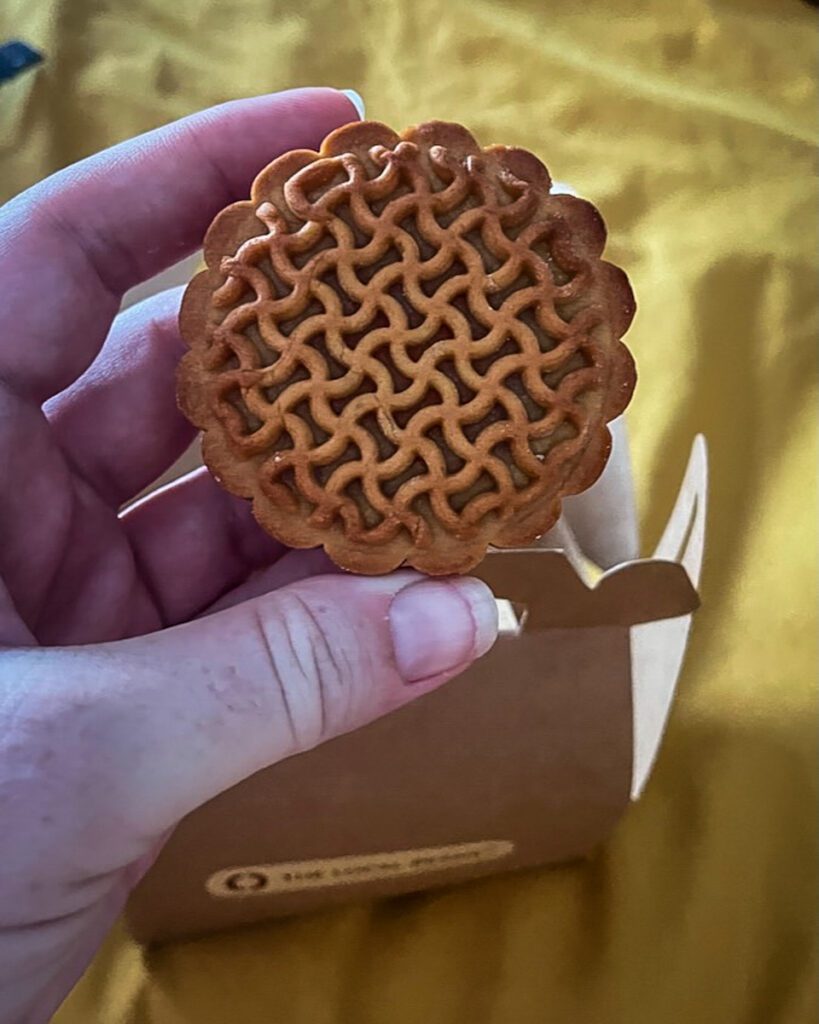
Mooncakes are special in Vietnamese culture, especially during the Mid-Autumn Festival, also known as Tết Trung Thu. Celebrated on the 15th day of the eighth lunar month, typically in September or October, this festival is a time for families to come together, express gratitude, and appreciate the beauty of the full moon.
Mooncakes are round or square pastries with a rich, dense filling, usually encased in a thin, intricately patterned pastry crust. They come in various flavors and fillings, including lotus seed paste, red bean paste, nuts, and sometimes salted duck egg yolks, adding a savory touch to the sweetness.
With their round shape symbolizing completeness and unity, mooncakes are often exchanged between family members, friends, and business associates as a gesture of goodwill and harmony.
My landlord in Da Nang gifted me some, as did the coworking cafe I was writing from!
During the festival, vibrant lanterns light up the streets, and dragon and lion dances add to the festive atmosphere.
Where to order: Mooncakes are widely available in the weeks leading up to the Mid-Autumn Festival. You can find them in bakeries, supermarkets, and specialty shops throughout Vietnam.
Round up of Vietnamese street food
Here’s a recap of all the best Vietnamese street food dishes to try so you can see everything in one place.
- Pho
- Banh Mi
- Vietnamese coffee (and beyond!)
- Bun Bo Hue
- Bun Cha
- Banh Xeo
- Com Ga (Chicken and Rice)
- Banh Cuon
- Bun Bo Nam Bo
- Goi Cuon (spring rolls)
- Cao Lau Noodles
- Mi Quang Noodles
- Morning Glory
- White Rose Dumplings
- Papaya salad
- Tropical fruits
- Nem Cua Be
- Rice wine, aka “Happy Water”
- Bun Rieu
- Fresh seafood and snails
- Grilled goat
- Bamboo duck
- Bun Cha Gio
- Bot Chien
- Banh Bao
- Bonus: Mooncakes
Vietnamese cuisine by region
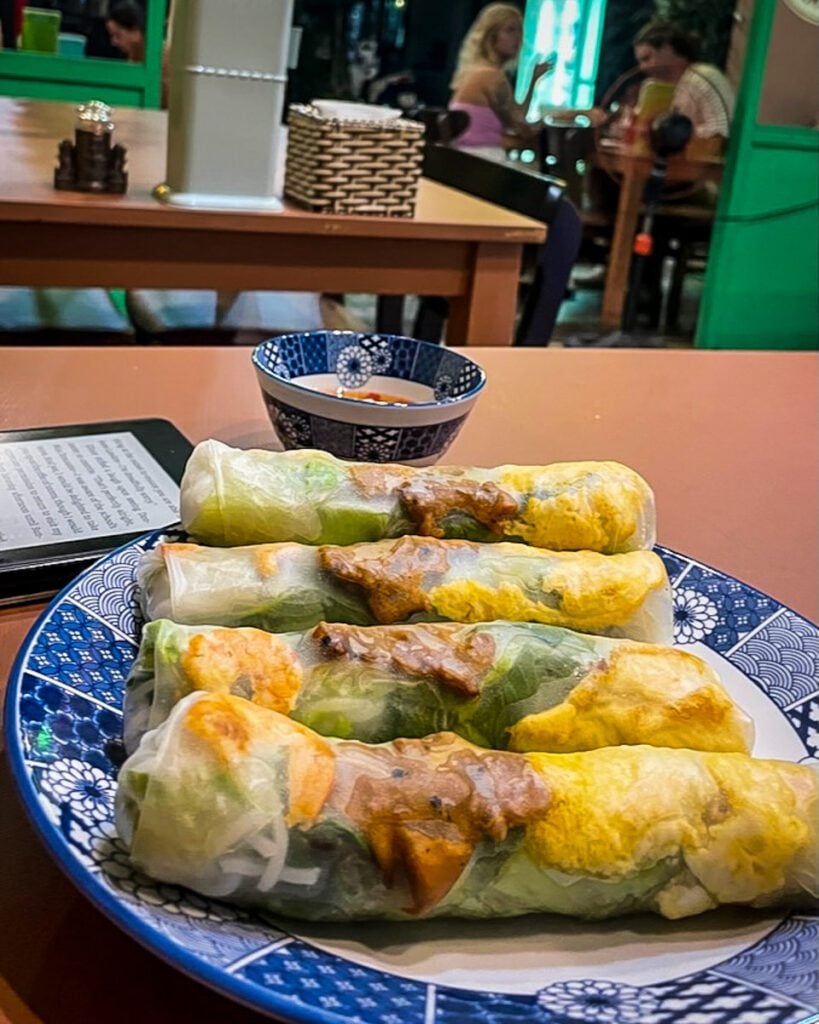
Vietnamese street food varies by region, each offering distinct flavors. Here’s a quick look at the main areas:
North Vietnam (Hanoi):
Influenced by China, the North favors heartier dishes with freshwater ingredients. Noodles are a staple, and markets in Hanoi offer simple, brothy dishes such as one of my favorites, Bun Cha. You should also try the world-renowned Pho and the unique egg coffee, which originated in Hanoi.
Central Vietnam (Hue, Da Nang, Hoi An):
Balancing north and south influences, this region has spicy dishes like Bun Bo Hue (spicy beef noodle soup) and unique options like Cao Lau with Japanese-style noodles.
South Vietnam (Ho Chi Minh City, Mekong Delta):
Cambodia and Thailand influence the South and offer a mix of sweet, salty, sour, and spicy flavors. Pho is a staple, and the Mekong Delta provides fresh produce and seafood. Famous Banh Xeo also originated in the Mekong Delta.
Vietnamese ingredients
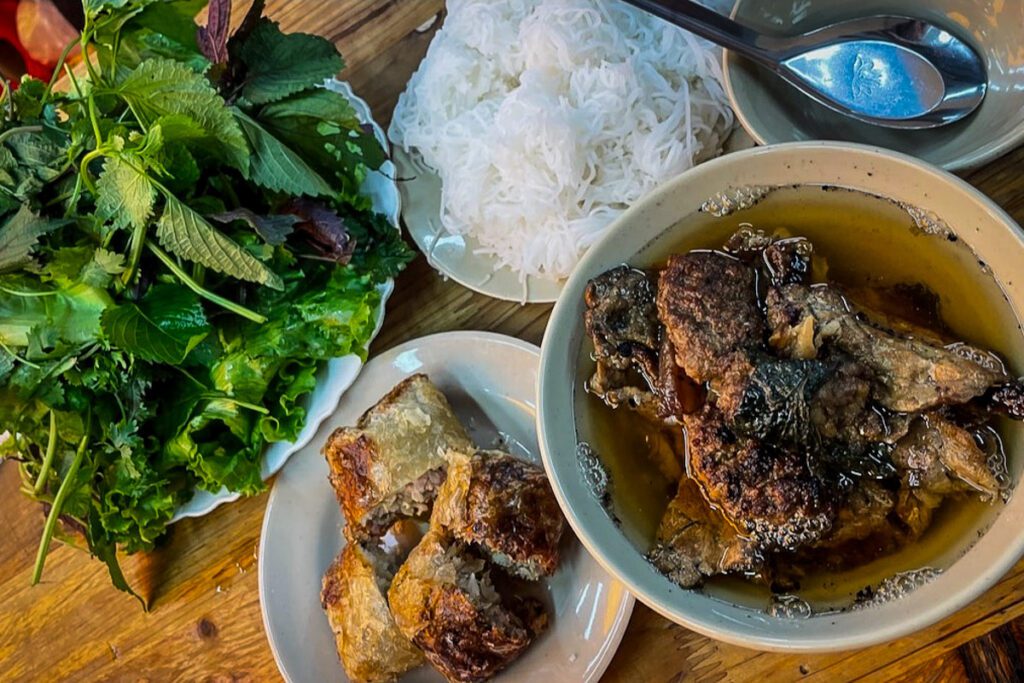
Vietnamese street food is extremely flavorful, and its distinctive taste is crafted from diverse ingredients.
Here’s a peek into some of the key elements that bring Vietnamese dishes to life:
- Jasmine Rice: A staple in Vietnamese cooking and served alongside almost every meal in Vietnam, including stir-fries and meat dishes.
- Fish Sauce (Nước Mắm): Often hailed as the soul of Vietnamese cuisine, fish sauce is a fermented liquid made from salt and fish. It adds a salty and savory depth to many Vietnamese dishes.
- Rice Vinegar (Dấm Gạo): This vinegar made from fermented rice contributes a slightly sweet and tangy note to various Vietnamese recipes, balancing flavors beautifully.
- Rice Noodles (Bánh Phở, Bún, and more): A staple in Vietnamese dishes, rice noodles come in various shapes and sizes, offering a versatile base for many noodle soups and stir-fries.
- Fresh Herbs (Mint, Basil, Cilantro): Vietnamese cuisine is known for its abundant use of fresh herbs. Mint, basil, and cilantro add brightness and aromatic complexity to dishes like pho and spring rolls.
- Pickled Vegetables ( Đồ Chua): Pickled carrots, daikon radish, and garlic are common accompaniments to many Vietnamese meals. They add crunch, tartness, and a hint of sweetness.
- Sambal Oelek (Nuoc Cham): This spicy and savory sauce is made from ground chili peppers, garlic, sugar, and vinegar. It pairs well with many main ingredients in Vietnamese cuisine, such as noodles and vegetables.
- Lemongrass (Xả): This stalky herb imparts a distinct lemony-mint flavor to Vietnamese dishes, enhancing soups, marinades, and stir-fries.
- Ginger and Garlic (Gừng và Tỏi): These aromatic ingredients are fundamental in Vietnamese cooking, providing depth and complexity to various dishes.
- Bean Sprouts (Giá): Commonly used as a crunchy garnish, bean sprouts add texture and freshness to dishes like pho and bánh mì.
- Chilies (Ớt): Whether fresh or in the form of chili sauce, Vietnamese cuisine embraces a bit of heat to elevate the flavor profile.
- Star Anise (Hoa Hồi): This star-shaped spice is a key player in pho broth, imparting a warm and subtly sweet essence.
- Vietnamese Cinnamon (Fỏi Quế): This darker variety of cinnamon is intensely flavorful and works wonders in dishes like bánh xèo and bún.
- Shallots (Hành Tỏi): Offering a milder and sweeter taste than regular onions, shallots are a common aromatic base in Vietnamese cooking.
- Fresh Lime or Kumquat (Chanh): Bright and tangy, a squeeze of fresh lime or sprinkle of kumquat provides an acidic finish to many dishes.
- Coconut Milk (Nước Cốt Dừa): Silky and creamy, coconut milk adds depth to desserts like chè bà ba and savory soups like canh chua.
Vietnamese vocabulary to know
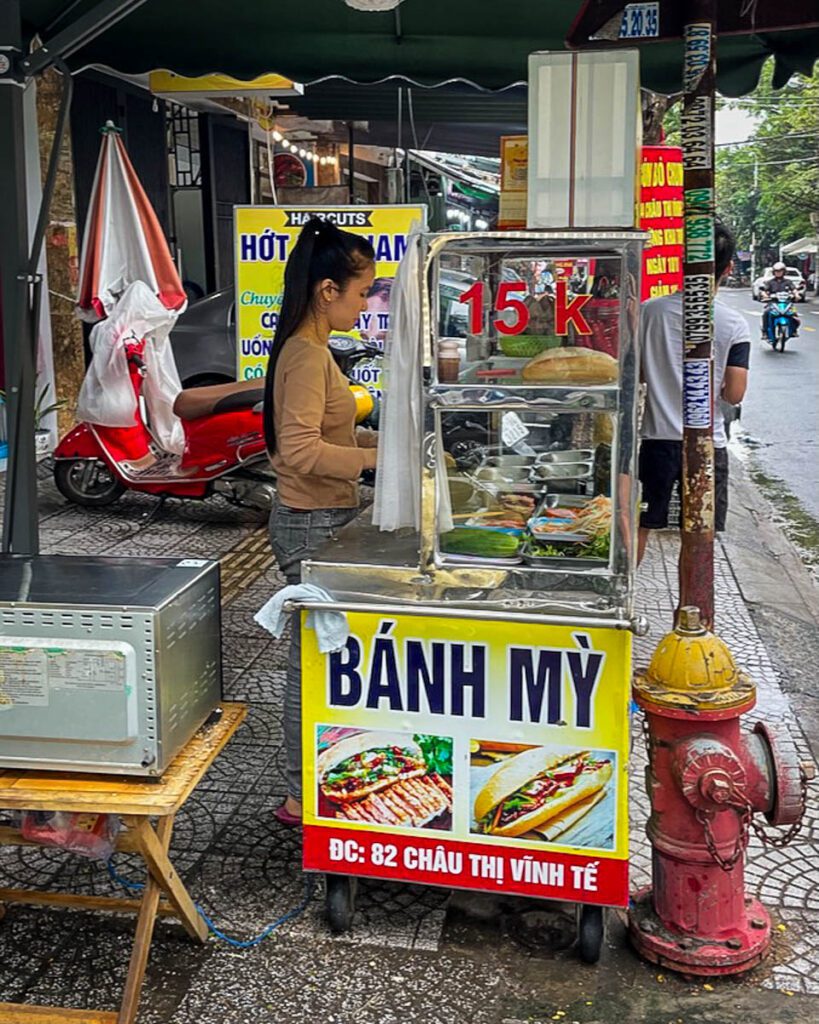
Knowing a bit of Vietnamese culinary lingo can enhance your dining experience and help you decode the menu. Here are some essential terms:
- Phở: Pronounced “fuh,” this signifies the iconic Vietnamese noodle soup, typically featuring beef (Phở Bò) or chicken (Phở Gà).
- Bánh: A term often denoting baked or grilled items, like Bánh Mì (sandwich) or Bánh Xèo (sizzling pancake).
- Gỏi: This implies salads, and you’ll often find fresh and flavorful options like Gỏi Cuốn (spring rolls).
- Bún: Refers to rice vermicelli dishes, such as Bún Chả (grilled pork with vermicelli).
- Cơm: Simply translates to rice, a staple in Vietnamese cuisine. Keep an eye out for dishes like Cơm Gà (chicken rice).
- Chả: Indicates a type of grilled or fried meat, like Chả Giò (spring rolls) or Chả Cá (grilled fish).
- Nước: Means sauce or broth, a crucial element in many Vietnamese dishes. Nước Mắm is fish sauce, a fundamental flavor enhancer.
- Bò: Signifies beef, commonly seen in dishes like Bò Lúc Lắc (shaking beef) or Bò Kho (beef stew).
- Gà: Represents chicken, as seen in dishes like Gà Xào Sả Ớt (lemongrass chili chicken).
- Hải Sản: Translates to seafood, often featured in coastal delicacies like Hải Sản Nước Mía (seafood in sugarcane).
Phrases to help you navigate dietary preferences
- Chay: Indicates vegetarian. You can say, “Tôi ăn chay” (I am vegetarian) to communicate your dietary choice.
- Không Gluten: Translates to gluten-free. If you have a gluten allergy or preference, you can say, “Không có gluten, xin cảm ơn” (No gluten, thank you).
Things to know about Vietnamese food

- Book a Tour: To immerse yourself in the culture, consider taking a cooking class or food tour, where you can learn to make some of the dishes and understand the history behind them. Food tours are one of my favorite ways to explore a new city – I took one in Hanoi AND one in Ho Chi Minh!
- Common Ingredients: Authentic Vietnamese food often includes fish sauce, lemongrass, chili, garlic, and fresh herbs. MSG is often added to dishes to give extra flavor, so be prepared for a salty taste.
- Intentionally Bland: Many soups and dishes are meant to be bland so that you can add your own flavor with sauces or condiments. Always taste the broth before adding to it.
- Regionality: Different regions have slightly different tastes—for example, northern cuisine tends to be sweeter, while southern cuisine has more spice. I recommend your Vietnam itinerary include multiple regions if you have the time!
- Balanced Flavors: Balance is important in Vietnamese cooking, so it’s rare to find anything too spicy or sweet.
- Order the House Specialty: If the restaurant’s name is a dish, it’s often best to order it, as the vendors usually specialize in that.
- Tiny Plastic Chairs: Don’t be surprised to find kid-sized plastic chairs and communal seating when dining at more traditional street vendors. My food tour guide told me that most street vendors operate illegally, and having tiny plastic chairs and tables lets them quickly pack up before getting fined.
- Chopsticks: At the table, chopsticks and silverware will be provided. Giving your chopsticks a quick wipe with your napkin before digging in is a good idea.
- Sharing is Caring: A communal bowl of greens and garnish is usually on the table. Unused greens get reused by the next customer. It’s best not to think too much about it.
- Street food is Cheap: Street food is a great way to experience the flavors of Vietnam, with a plate usually costing only $1-2 USD max. Most sit-down Vietnamese restaurants cost less than $10 USD per plate.
- Breakfast: For breakfast, many locals will have noodles or rice. Some of the best street stalls are only open for breakfast and lunch. Ordering a big bowl of savory noodles at 7 am can feel strange, but it’s fun, too!
- Limited English is spoken: If dining in a very local space, don’t worry if English is not spoken. Hold up 1 finger for how many plates of food you would like or point to someone’s plate or cup of what you want to order. I’ve heard stories of tourists not feeling welcome to eat at super local places, but I’ve never had that experience.

Cat is a hungry solo female traveler in her 30s who left a 6-figure job in NYC to travel (and taste!) the world. She is determined to prove there are ways to backpack the world on a budget without fully sacrificing the “grown-up” lifestyle you love. You can follow along on her adventures on her blog, Cat is Out of the Office, and Instagram.
Are you planning a trip to Vietnam?
We have TONS of resources on travel in Vietnam and destinations throughout the country. Check out our Ultimate Vietnam Travel Guide for all the answers to your most burning questions, or read some of our favorite articles below.
- Perfect 1 Month Itinerary for Vietnam
- Best Time to Visit Vietnam: When to Go & When to Avoid!
- Fun Things to Do in Hoi An
- Budget-Friendly Things to Do in Hanoi
Save this article on Pinterest for later!
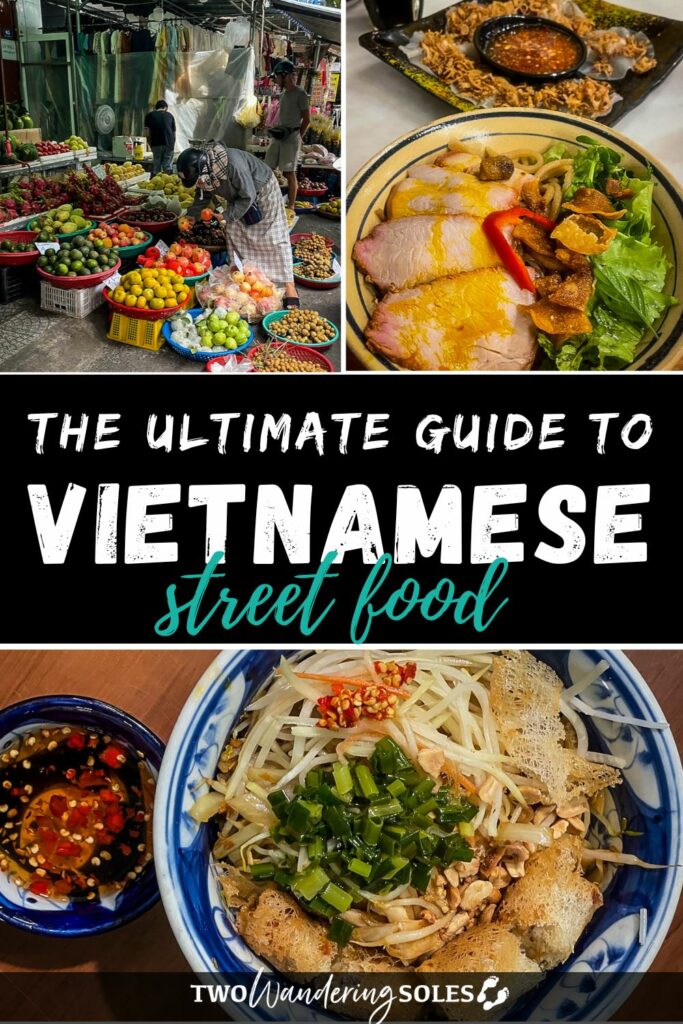
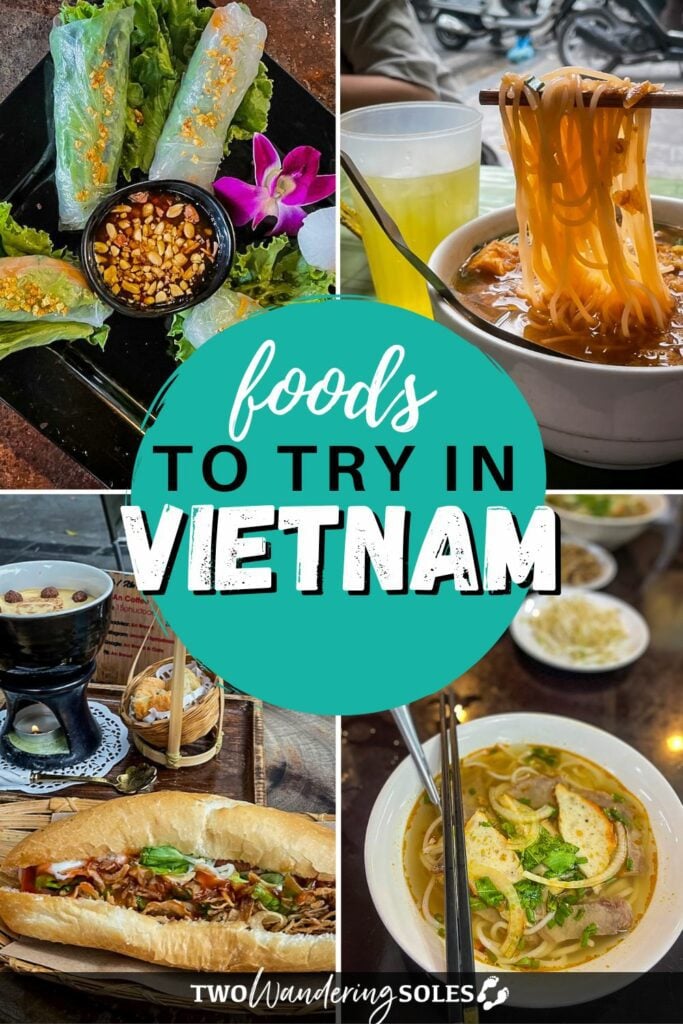
We want to hear from you!
Do you love Vietnamese cuisine as much as we do? Which of the Vietnamese street food dishes on this list are you most excited to try? Which is already your favorite? Leave us a comment below and we’ll do our best to get back to you!
